- ADMIN AREA MY BOOKSHELF MY DASHBOARD MY PROFILE SIGN OUT SIGN IN

THE HORSE AND HIS BOY
From the chronicles of narnia series , vol. 5.
by C.S. Lewis illustrated by Pauline Baynes ‧ RELEASE DATE: Oct. 5, 1954
For his followers, and, we hope, anybody else who happens in, C.S. Lewis writes another wonderful Narnian adventure. The setting is familiar. There is the eastern flavour to his make-believe kingdoms and great Aslan the Lion is still Narnia's protector. But for a new hero there is Shasta, a slave boy in the tyrannical land of Calormen, and of unknown parentage, who escapes to the free north with Bree, one of Narnia's talking horses. En route, they meet Aravis, a Calormene princess also in flight because of an impending forced marriage, and together they help snuff out a Calormene plot to attack not only Narnia but its brother land of Archenland, of which Shasta turns out to be a lost prince. A beautifully written tale to read aloud as well, in which C.S. Lewis' talents seem to flower more than ever.
Pub Date: Oct. 5, 1954
ISBN: 978-0-06-023488-1
Page Count: -
Publisher: Macmillan
Review Posted Online: April 10, 2012
Kirkus Reviews Issue: Oct. 1, 1954
CHILDREN'S SCIENCE FICTION & FANTASY
Share your opinion of this book
More In The Series

BOOK REVIEW
by C.S. Lewis illustrated by Pauline Baynes

by C.S. Lewis & illustrated by Pauline Baynes
More by C.S. Lewis

THE SCHOOL FOR GOOD AND EVIL
From the school for good and evil series , vol. 1.
by Soman Chainani ; illustrated by Iacopo Bruno ‧ RELEASE DATE: May 14, 2013
Rich and strange (and kitted out with an eye-catching cover), but stronger in the set pieces than the internal logic.
Chainani works an elaborate sea change akin to Gregory Maguire’s Wicked (1995), though he leaves the waters muddied.
Every four years, two children, one regarded as particularly nice and the other particularly nasty, are snatched from the village of Gavaldon by the shadowy School Master to attend the divided titular school. Those who survive to graduate become major or minor characters in fairy tales. When it happens to sweet, Disney princess–like Sophie and her friend Agatha, plain of features, sour of disposition and low of self-esteem, they are both horrified to discover that they’ve been dropped not where they expect but at Evil and at Good respectively. Gradually—too gradually, as the author strings out hundreds of pages of Hogwarts-style pranks, classroom mishaps and competitions both academic and romantic—it becomes clear that the placement wasn’t a mistake at all. Growing into their true natures amid revelations and marked physical changes, the two spark escalating rivalry between the wings of the school. This leads up to a vicious climactic fight that sees Good and Evil repeatedly switching sides. At this point, readers are likely to feel suddenly left behind, as, thanks to summary deus ex machina resolutions, everything turns out swell(ish).
Pub Date: May 14, 2013
ISBN: 978-0-06-210489-2
Page Count: 496
Publisher: Harper/HarperCollins
Review Posted Online: Feb. 12, 2013
Kirkus Reviews Issue: April 15, 2013
CHILDREN'S SCIENCE FICTION & FANTASY | CHILDREN'S SOCIAL THEMES

by Soman Chainani ; illustrated by Iacopo Bruno

More by Soman Chainani

by Soman Chainani ; illustrated by RaidesArt

by Soman Chainani ; illustrated by Julia Iredale
More About This Book

BOOK TO SCREEN

SNOW PLACE LIKE HOME
From the diary of an ice princess series.
by Christina Soontornvat ; illustrated by Barbara Szepesi Szucs ‧ RELEASE DATE: June 25, 2019
A jam-packed opener sure to satisfy lovers of the princess genre.
Ice princess Lina must navigate family and school in this early chapter read.
The family picnic is today. This is not a typical gathering, since Lina’s maternal relatives are a royal family of Windtamers who have power over the weather and live in castles floating on clouds. Lina herself is mixed race, with black hair and a tan complexion like her Asian-presenting mother’s; her Groundling father appears to be a white human. While making a grand entrance at the castle of her grandfather, the North Wind, she fails to successfully ride a gust of wind and crashes in front of her entire family. This prompts her stern grandfather to ask that Lina move in with him so he can teach her to control her powers. Desperate to avoid this, Lina and her friend Claudia, who is black, get Lina accepted at the Hilltop Science and Arts Academy. Lina’s parents allow her to go as long as she does lessons with grandpa on Saturdays. However, fitting in at a Groundling school is rough, especially when your powers start freak winter storms! With the story unfurling in diary format, bright-pink–highlighted grayscale illustrations help move the plot along. There are slight gaps in the storytelling and the pacing is occasionally uneven, but Lina is full of spunk and promotes self-acceptance.
Pub Date: June 25, 2019
ISBN: 978-1-338-35393-8
Page Count: 128
Publisher: Scholastic
Review Posted Online: March 26, 2019
Kirkus Reviews Issue: April 15, 2019
More by Erika Lee

by Erika Lee & Christina Soontornvat

by Sarah Mlynowski & Christina Soontornvat ; illustrated by Maxine Vee

by Christina Soontornvat ; illustrated by Kevin Hong
- Discover Books Fiction Thriller & Suspense Mystery & Detective Romance Science Fiction & Fantasy Nonfiction Biography & Memoir Teens & Young Adult Children's
- News & Features Bestsellers Book Lists Profiles Perspectives Awards Seen & Heard Book to Screen Kirkus TV videos In the News
- Kirkus Prize Winners & Finalists About the Kirkus Prize Kirkus Prize Judges
- Magazine Current Issue All Issues Manage My Subscription Subscribe
- Writers’ Center Hire a Professional Book Editor Get Your Book Reviewed Advertise Your Book Launch a Pro Connect Author Page Learn About The Book Industry
- More Kirkus Diversity Collections Kirkus Pro Connect My Account/Login
- About Kirkus History Our Team Contest FAQ Press Center Info For Publishers
- Privacy Policy
- Terms & Conditions
- Reprints, Permission & Excerpting Policy
© Copyright 2024 Kirkus Media LLC. All Rights Reserved.
Popular in this Genre
Hey there, book lover.
We’re glad you found a book that interests you!
Please select an existing bookshelf
Create a new bookshelf.
We can’t wait for you to join Kirkus!
Please sign up to continue.
It’s free and takes less than 10 seconds!
Already have an account? Log in.
Trouble signing in? Retrieve credentials.
Almost there!
- Industry Professional
Welcome Back!
Sign in using your Kirkus account
Contact us: 1-800-316-9361 or email [email protected].
Don’t fret. We’ll find you.
Magazine Subscribers ( How to Find Your Reader Number )
If You’ve Purchased Author Services
Don’t have an account yet? Sign Up.
- SUBSCRIBE NOW

Here’s Why ‘The Horse and His Boy’ is the Absolute Best Narnia Book

Author Reveals How ‘The Matrix’ and ‘Terminator’ Are Connected — and Biblical

Russell Brand Reflects on First Month as a Christian: ‘It’s Been a Big Change’

Steven Furtick Facing Backlash Because Elevation Church Won’t Use Words Like “Resurrection” On Easter Invites

It Looks Like Chandler Moore Is No Longer Part of Maverick City Music

Eternal Real Estate? A Church in Mexico Is Selling Plots of Land in Heaven

The announcement that Greta Gerwig is joining Netflix version of the Narnia Cinematic Universe (hereafter: NCU) is exciting for a lot of reasons. For one thing, the most recent effort to bring The Chronicles of Narnia to the screen—ending with 2010’s Voyage of the Dawn Treader— was a series of diminishing returns. The franchise clearly wanted to be The Lord of the Rings, but it couldn’t quite figure out how to make the source material do what it wanted.
For another, no attempt at a Narnia adaption has made it past The Silver Chair , leaving some of the best and weirdest tales just sitting there on the shelf. There’s The Magician’s Nephew —a sort of Narnia Begins yarn—and The Last Battle , an uncharacteristically harrowing final chapter.
The best story still on the shelf is fifth in the series, The Horse and His Boy. It’s different than the other books — more economic in pacing but also wider in scope. It builds out the world around Narnia in surprising, substantive and even funny ways. And the Christian allegory, which could veer into being a bit too on-the-nose in some of the other books, is handled here with a tenderness that renders it much more powerful. Again: It’s the best of the Narnia books.
A bit of spoiler-free context. The Horse and His Boy follows the adventures of two talking horses, Bree and Hwin, and their human “owners” Shasta and Aravis. The book finds them in Narnia’s neighboring country of Calormen, which Lewis largely modeled after the Persian and Ottoman Turkish empires (the depiction, it must be noted, is not without some cringe-y racial stereotypes.) Bree and Hwin are Narnian horses, and they convince Shasta and Aravis to flee back to their home country. Thus begins a journey through Calormen and other neighboring Narnian countries in which very little goes as planned.
Though it comes fifth in the series, the events of The Horse and His Boy actually take place during the reign of Peter, Susan, Edmund and Lucy, a time that was passed over in a couple of sentences at the end of The Lion, the Witch and the Wardrobe . Lewis has great fun dropping what we would today call easter eggs, leaving his most beloved Narnian creations at the peripheral of the narrative, save for a few thrilling moments.
This book’s delights abound, but for starters, there’s the simplicity of the plot, which is as straightforward an escape story as they come. Things clip along in a straight line at a brisk place, with little time spent depicting the flora and fauna of Lewis’ imaginative world. The fact that so little of the book takes place in Narnia makes the bursts of magic in this stranger land feel more enlivening and satisfying when they do appear. Even something as simple as the sound of the “clear and sharp and valiant” Narnian trumpet crystalizes the country in new and memorable ways.
And there are the women. The Lion, the Witch and the Wardrobe is criticized for Lewis’ old-fashioned takes on some of his female characters (Susan and Lucy are pointedly forbidden from fighting) but Aravis is a stupendous character in The Horse and His Boy ; a highborn Calormene as courageous and quick-witted as she is stubborn and hotheaded, touched with a tremendous talent for storytelling. Lewis’ writing could occasionally fall prey to outdated notions about gender and race, but a strong, daring young Arabic woman still feels radical even by the standards of today’s children’s literature. And this is to say nothing of her gentle, timid equine companion Hwin or her loyal if a little daft friend Lasaraleen. The Horse and His Boy vaults over the Bechdel Test with ease.
But among the The Horse and His Boy fandom (there aren’t many of us, but we’re out there), the book’s best part might just be its handling of Aslan. A central figure in most of the Chronicles, Aslan is left largely in the shadows heres. He’s a mysterious presence, teased as something of a bogeylion in Calormene lore, even dismissed by some Narnians as pure metaphor in one of Lewis’ sharper digs at a certain type of biblical hermeneutic.
But when Aslan does actually appear, his presence lands with a gentle gravitas. Lewis’ famous description of Aslan as “good, but not safe” is made implicit here, as the lion’s presence invokes in Shasta “a different sort of trembling …Yet he felt glad too.” Lewis’ chief theological concern in The Horse and His Boy is providence. In this story, misfortune, chance meetings and dumb luck are all part of the same divine plot in service of greater, mysterious ends. Shasta and Aravis’ limited view of their own lives and plans are deftly woven into matters of far greater consequence without their fully realizing it.
Lewis was obsessed with this theme across all his writing: What are we to make of a loving and all-powerful God amid a world with so much heartache? Lewis wrestles with the question in everything from A Grief Observed to Till We Have Faces , and The Horse and His Boy doesn’t deliver any easier, simplistic answers for the sake of its younger target audience. In Lewis’ narrative, many traumatic events in Aravis and Shasta’s life can be attributed to a grander divine plan. But not every ill is so easily resolved, and not every question is patly answered. As Aslan says, “I tell no one any story but his own.”
The Netflix plan for this book and the others is vague at this point, but it sounds like the Narnia series will be brought to life via a hybrid of movies and shorter TV shows. That’s a smart move. An episodic structure would allow creators to slow down and dig into smaller moments from the series while a film-length construction would leave room for razzle dazzle when it suits the story.
In addition to allowing for savvier storytelling, the Netflix model might allow us to see what Shasta and Aravis could not. With increased flexibility to the narrative structure, viewers will be able to see even more of the canonical context of the world of Narnia — its people, neighboring lands and political tensions. We will, in a sense, see everyone else’s story: the unseen hands, the unmoved movers and the grand design.
There’s a lot of nerves out there about whether Netflix will be able to faithfully adapt the series. That’s understandable, but probably not worth fretting about until we know more. A blessing from Lewis’ stepson and Douglas Gresham, the de facto custodians of Narnia lore, seems like a good sign if nothing else, but more heartening is the prospect of the new format bringing new life and nuance to themes Lewis could only glance upon in his original series.
Worst case scenario, the recent news is as good a reason as any to revisit all these books, but especially The Horse and His Boy . It’s the best one, after all.

Christian Apparel Isn’t Cheesy Anymore and We’ve Got Proof

A Historic Black Church Was Awarded $1 Million in Lawsuit Against the Proud Boys

Yesterday Was the Hottest Day in Recorded History
Leave a reply.
You must be logged in to post a comment.
Actor Joshua Bassett: ‘The Only Time I Found Peace Was the Moment I Accepted Jesus’

Five Ways to Stay On Top of Your Finances

‘Scrubs’ Meets ‘Abbott’ in New NBC Mockumentary

X Might Be Getting Rid of Like and Comment Counts. Here’s Why That’s a Win for Mental Health

This Guy Got So Fed Up With Dating Apps He Rented a Billboard in Philadelphia to Find a Date

How I Broke Free From Religion

Knowing Your Attachment Style Will Change Everything About Your Relationships

How Our View of God Affects Our Anxiety

Six Ways to Stand Out at Your Job

Imane Khelif’s Boxing Victory Sparks Gender Controversy at the Paris Olympics

Aaron Cole’s Freestyle on ‘Sway in the Morning’ is a Must-Watch

This Was a Big Week for Forrest Frank and Brandon Lake
© 2023 RELEVANT Media Group, Inc. All Rights Reserved.
You’re reading our ad-supported experience

SEARCH MY BOOK REVIEWS
Subscribe to feed.
SUBSCRIBE TO EMAILS
Enter your email address:
THE MASTER LIST
- Books I've read so far...

Home of the Lucy Maud Montgomery Reading Challenge
Home of the chronicles of narnia reading challenge, view posts by category.
- Adoption (10)
- Adventure (12)
- Author Highlight (17)
- Biography (30)
- Blog News (18)
- Blog Tour (10)
- Bookclub (100)
- Booking Through Thursday (27)
- Books for Babies (10)
- C.S. Lewis (10)
- Carrie's Favorites (16)
- Challenge (40)
- Children's Classics (115)
- childrens (133)
- Christian Fiction (48)
- Christianity (218)
- Christmas (76)
- Chronicles of Narnia Reading Challenge (71)
- Classics (83)
- Community (102)
- Disney Books (26)
- Early Chapter Book (5)
- Fantasy (17)
- fiction (3)
- General Fiction (96)
- Giveaway (217)
- Guest Post (15)
- Historical Fiction (27)
- History (74)
- Hymn Encouragement (9)
- I'll Pass (1)
- Jonathan (20)
- Kid Picks (20)
- L.M. Montgomery Challenge (122)
- Learning with Kids (104)
- marriage (16)
- Memoir (56)
- MIddle Grade (113)
- Misc. (157)
- Movie Review (36)
- Mystery (24)
- Narnia Week (16)
- Non-fiction (23)
- Non-Fiction (14)
- Ocean Life (7)
- Parenting (32)
- Personal (99)
- Publisher Highlight (11)
- Read Aloud (4)
- Read Aloud Thursday (81)
- Reader's Diary (8)
- Reading as a Ministry (4)
- resources (1)
- Romance (1)
- Science Fiction (4)
- Social Issues (16)
- Western (3)
- What's On Your Nightstand (71)
- Women's Interests (62)
- YA Fiction (36)
- Year in Review (3)
Friends and Followers
Closed chapters, monday, july 14, 2014, the horse and his boy, by c.s. lewis.

"I say," put in Shasta in a rather shocked voice, "oughtn't you to say 'May he live forever'?" "Why?" asked the Horse. "I'm a free Narnian. And why should I talk slaves' and fools' talk? I don't want him to live forever, and I know he's not going to live forever whether I want him to or not. And I can see you're from the free north too. No more of this southern jargon between you and me!"
Now this I say and testify in the Lord, that you must no longer walk as the Gentiles do, in the futility of their minds. They are darkened in their understanding, alienated from the life of God because of the ignorance that is in them, due to their hardness of heart. They have become callous and have given themselves up to sensuality, greedy to practice every kind of impurity. But that is not the way you learned Christ!— assuming that you have heard about him and were taught in him, as the truth is in Jesus, to put off your old self, which belongs to your former manner of life and is corrupt through deceitful desires, and to be renewed in the spirit of your minds, and to put on the new self, created after the likeness of God in true righteousness and holiness. Therefore, having put away falsehood, let each one of you speak the truth with his neighbor, for we are members one of another. Ephesians 4:17-25
". . . [I]f Bree had had a Tarkaan on his back at that moment to make him go on, he would have found that he was good for several hours hard going. But one of the worst results of being a slave and being forced to do things is that when there is no-one to force you any more you find you have almost lost the power of forcing yourself."
“Please,' she said, 'You're so beautiful. You may eat me if you like. I'd rather be eaten by you than fed by anyone else.”
7 comments:
Great post! We're about three or four chapters in, and so far everyone's enjoying it.
Love your thoughts. : ) I love how we can all read the same book and come away with completely different (yet complementary) deep truths that minister to us.
I found I loved this one more as an adult because of those themes than I did as a kid. In fact, my reaction pretty much parallels yours.
I enjoyed revisiting the story through your post. I remember not liking it quite as well as the others at the beginning, too, but appreciating it a lot by the end.
Sigh. Oh yes! Excellent reflections.
SO glad you changed your mind. I LOVE The Horse and His Boy.
Post a Comment

| Synopsis | A young slave boy and a Narnian horse flee north from slavery to the free lands of Narnia, stumbling upon a dangerous conspiracy in the process. |
| Author | C.S. Lewis |
| Publisher | Geoffrey Bles |
| Genre | Fantasy |
| Length | 199 Pages |
| Release Date | September 6, 1954 |
I recently had the opportunity to visit The Museum of the Bible in Washington DC on a business trip and bought a ticket to The Logos Theater’s production of The Horse And His Boy , a Lion King -esque stage play of the beloved fifth book in the Narnia series that was never adapted to film. The production was absolutely inspiring and led me to go back to the book I had largely never gotten to read. I am glad it did because working through the story twice last month helped me deeply examine this strange side story and contemplate C.S. Lewis’s intentions for one of the strangest books in his beloved canon.
Content Guide
Spiritual Content: The book is part of a series that explores Christian themes in a whimsical fantasy setting. Violence: Some fantasy violence with descriptions of battles, blood, and severe injuries Language/Crude Humor: None Sexual Content: Several characters get married, and another character threatens to marry a woman after capturing her and killing her brother. Drug/Alcohol Use: Some references to alcohol consumption Other Negative Themes: None Positive Content: Themes of conversion, suffering, and pain in the Christian life

The Narnia series famous for being highly conspicuous. Lewis’s friend and fellow fantasy author J.R.R. Tolkien was a critic of the books right out of the gate and disliked the kind of obvious scattershot parable that Lewis was exploring within the context of the saga. But that did not stop Lewis, nor did it stop generations of readers from falling in love with his magical realms and unique retelling of Christian ideas and themes.
I’ve been slowly going back and reading the Narnia books for the first time since when I was very young. And reading them as an adult, you definitely interact with them differently. The Lion, the Witch, and the Wardrobe is still the best of the narratives from a storytelling perspective. However, the books themselves have a life all their own, even as they start getting less subtextual and more aggressively theological towards the end of the series.
My recent reading of The Magician’s Nephew left me with a sense that it was among the more well-thought-out and creative of the stories, as a curious retelling of the Genesis creation account set in Narnia. Recently, though, that thought has changed during my first time reading The Horse and His Boy . Weeks later, I’ve gone through the story twice, and I cannot stop thinking about it.
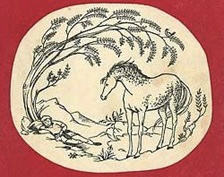
The Horse and His Boy , chronologically, is a bizarre book. It was one of the last books in the series that Lewis published. However, it was set during the events of Lion, the Witch, and the Wardrobe between the crowning of the four Kings and Queens of Narnia and the children’s return to the Wardrobe, during the decades they sat on the thrones. We’re treated to a new area of the story populated with strange characters and factions that were unfamiliar in the previous book, but who implicitly play a larger role in Prince Caspian in the distant future.
The Horse and His Boy is a peripheral story to the opening books in the Narnia franchise — smaller, more intimate, and less connected to the major events before The Last Battle . At its heart lay a pair of very powerful conversion stories, both loaded with clear symbolism and real-life analogs. A story of two people running away from home to seek the kingdom of Narnia — and one of them just so happens to be a talking horse.
The story picks up in the far southern lands of Narnia’s realm. A tribe of Middle-Eastern-coded slave laborers and fishermen are living under the heel of cruel slavemasters and rulers. Among them is an adopted boy named Shasta, who regularly faced beatings and cruelty from his unknowingly adoptive father. When he finds out the truth and that he is set to be sold to a cruel slave driver, he stumbles upon a Narnian horse named Bree that gives him the chance to flee north to his heavenly homeland and freedom.
After they make their daring escape, Shasta and Bree stumble upon another young southern princess fleeing with her own Narnian horse and a larger political conspiracy. The Prince of their realm is seeking to lay siege to Narnia by conquering its neighboring allied kingdom and leading an army against Narnia’s rulers. This simple story of two conversions escalates with the only hope of Narnia falling into the hands of these outsiders.

At times, the sheer volume of proper nouns can make the story a bit unwieldy to a first-time reader. We are meant to take away that this is setting the stage for the events of Prince Caspian , where humans have overrun Narnia and enslaved the free peoples and animals. But the book does not always clarify how it fits into the overall narrative. The previous chronological story gave no hint at the politics of this realm or how other humans fit into it. Nor did it disclose that Narnia is actually a smaller kingdom aligned with its neighbors against multiple large empires on the periphery of its magical realm. The density pays off upon reexamination, though. It’s a sprawling story for its size, with tremendous amounts of realpolitik and drama to its moral vision, helmed by some of the darkest themes and story concepts of the entire saga.
It is not hard to tell from the get-go what The Horse and His Boy is doing as a story. It is a classic tale of how converting to Christianity frees oppressed peoples from slavery, necessitating radical actions, breaking culture and family ties, and committing to a journey of pain, discomfort, and uncertainty that makes it challenging to move further and grow in faith.
The story carries echoes of the classic St. George and the Dragon , which is thematically an exploration of how Christianity frees enslaved peoples from Pagan superstition. After St. George walks into a town that is commanded to sacrifice a virgin to a man-eating dragon once a year, he slays the dragon, giving the people freedom from their arbitrary and horrific tyranny.

The Horse and His Boy makes for a powerful conversion story, and a dark one at that — a story about two people fleeing from a hostile and abusive culture to the freedom and love of Christ’s Church. Its darkness and content showcase how fraught of a reality that real-life story is. These characters are in constant danger from the get-go and have to conspire and survive in a world that is hostile to their goals.
What makes the book pay off so well is that it gives Aslan arguably his most powerful depiction in the entire series. Aslan appeared multiple times in unexpected forms prior to revealing himself to Shasta and Bree. As we come to realize, the daring escapes and close calls have actually been authored from the moment the story began. Aslan has been guiding these converts through the most painful moments of their lives, even appearing in horrific and painful forms to set the course of events in the right direction.
His conversations with the lead characters are greatly revelatory, giving the reader a sense that pain and suffering are vital parts of the Christian journey. It echoes Lewis’s own moral sentiment, best espoused in The Great Divorce , that all of a person’s life experience is ultimately revealed to be in service of the realization that we’ve been in heaven or hell the entire time without realizing it and that those moments are vital for our growth and specification.

This pays off most powerfully with Bree. Despite being a talking horse, he actually gets the most complicated and best writing of any character. He is introduced to the story as a war horse, confident and powerful in his abilities and strength. But as a Narnian horse, he remembers the homeland from his childhood and wants nothing but to return to his mother and people. Unfortunately, he cannot complete the quest on his own. He is too proud to admit that he’s made mistakes that separated him from his home and is too afraid to own up to them. He’s afraid he’s sullied by his experiences.
Most importantly, he’s too proud to recognize Aslan’s true nature until he’s directly faced with it and forced to swallow that pride. More than Shasta, Bree’s story captures some of the hardest feelings about what it means to truly convert to Christianity and how much emotion stifles that journey and holds us back, leaving us constantly tempted to return to slavery and despotism rather than embracing the glorious challenge of sanctification.
The Horse and His Boy has traditionally been considered one of the weirdest Narnia books. It was one of the last ones that Lewis wrote, despite retroactively sticking it early in the chronology of the story. It is a much smaller and darker story than many of the others, focusing on a smaller cast of characters with a much less noticeable impact than the Pevensie children or any of the other leading protagonists of the series. Yet I cannot stop thinking about it. It is told with the simplicity of a children’s fairy tale and unfurls, strangely and perhaps convolutedly, into a larger story about how our journeys transform us and how the hardest realities of life all work toward our good.
+ Great Central Story + Powerful Character Arcs and Themes + One of the Most Unique Narnia Stories
- Some massive conveniences and convoluted story points
The Bottom Line
The Horse and His Boy is neither the best nor most famous Narnia book, but its smaller story captures many of the most complicated and challenging themes that Christians face in their journey.
| Story/Plot | 9 |
| Writing | 9 |
| Editing | 8 |
Tyler Hummel
My son would really like to see more of Narnia chronicle stories made in to movies accurate to the books written by CS Lewis .
I always loved the Narnia books, in spite of the xian references, they are still great stories
What do you mean by, “xian references”?
The book was great.
Leave a Comment Cancel Reply
Save my name, email, and website in this browser for the next time I comment.
GDPR & CCPA:
Privacy overview.
Notice: All forms on this website are temporarily down for maintenance. You will not be able to complete a form to request information or a resource. We apologize for any inconvenience and will reactivate the forms as soon as possible.
Book Review
The horse and his boy — “the chronicles of narnia” series.
- Adventure , Christian Fiction , Fantasy

Readability Age Range
- HarperCollins Children's Books, a division of HarperCollins, Inc.
Year Published
This book has been reviewed by Focus on the Family’s marriage and parenting magazine . It is the third book in “The Chronicles of Narnia” series.
Plot Summary
During the Golden Age of Narnia, a boy called Shasta lives in Narnia’s neighboring country of Calormen. Shasta is the son of Arsheesh the fisherman, but when a Tarkaan lord of Calormen comes to stay at their hut, Shasta overhears their conversation and discovers that he was adopted. He also learns that Arsheesh is planning to sell him as a slave to the Tarkaan. The Tarkaan’s horse, Bree, is a talking horse from Narnia, and he and Shasta decide to make their escape from both of their masters.
After a few weeks of traveling toward Narnia, Bree hears another horse and rider nearby in the forest. Bree tries to avoid them, but the sound of a lion’s roar drives the two horses and riders closer together. After the lion stops chasing them, Bree hears the other horse speak. Hwin is a talking mare, and her rider, Aravis, is the runaway daughter of a wealthy Tarkaan. They are also running away to Narnia, so Bree proposes that all four of them travel together.
When the four companions arrive at the great city of Tashbaan, their plans are disrupted. Shasta is mistaken for a young prince and picked up off the street by Narnian nobles who are visiting Calormen. Shasta is taken back to the Narnians’ guest quarters and overhears their decision to flee from Calormen before they are forcibly detained. He also hears about a secret passage from the Calormen desert into Archenland and on to Narnia, which he commits to memory for his own upcoming journey. While the adults are out of the room, the real Prince Corin of Archenland returns. Shasta switches places with him and climbs out of a window to go find his companions. He leaves Tashbaan at sunset and has to stay the night near the Tombs of the Ancient Kings. The Tombs frighten him, but Shasta is comforted by a cat that stays with him and rests its back against him while he sleeps. The next morning, as Shasta wonders how long he should wait at the Tombs for his friends to join him, a Calormene servant leads Bree and Hwin out to the Tombs.
The story backtracks to tell what happens to Aravis while Shasta is with the Narnians. Immediately after Shasta is taken away, Aravis’ old friend Lasaraleen recognizes her in the street. To avoid further notice, Aravis joins Lasaraleen and goes home with her. Aravis needs to get out of Tashbaan with her horses, and Lasaraleen says Aravis can escape the city through an exit in the Tisroc’s garden. The Tisroc is the king of Calormen, and the two girls find themselves in danger when they sneak into his palace at night. The Tisroc and his son, Prince Rabadash, walk into the room where the girls are hiding, and they overhear the Prince’s plans to attack Archenland and Narnia. Aravis escapes from the palace undetected and meets up with Shasta and the horses at the Tombs.
The four companions travel through the desert to warn the Archenlanders of the impending attack. They are nearly overtaken by Rabadash’s cavalry on the second day. The horses gallop to stay ahead of the soldiers, and they are forced to run even faster when a lion begins chasing them. The lion claws Aravis’ back but leaves the rest of the group alone. It eventually goes away. Shasta finds that they have arrived at the home of the Hermit of the Southern March. The Hermit welcomes Aravis and the exhausted horses, but he tells Shasta that he must run onward without rest to warn King Lune of Archenland.
Shasta runs until he finds King Lune, but as he rides back with the king, he becomes lost inside a fog bank. Shasta is lamenting that nothing ever goes right for him when he hears something walking near him. It is Aslan, the great Lion. Aslan explains to Shasta that everything he has experienced has happened for a purpose. Aslan himself has been guiding and protecting Shasta on his journey. Aslan leaves Shasta, who finds that he is now in Narnia. Shasta meets some talking animals and dwarfs who take care of him and prepare food for him. The Narnian army comes by the dwarfs’ house, and Shasta meets Prince Corin again. Corin convinces Shasta to put on armor so the two of them can sneak into the battle with Rabadash.
The Hermit of the Southern March watches the battle while gazing into a magic pool. The Narnians win, and Shasta survives. Aslan visits Aravis, Bree and Hwin and explains some past events to them. When Aslan departs, Shasta comes back to see Aravis. Shasta is actually Prince Corin’s older twin brother, who was stolen away from Archenland in his infancy. His real name is Prince Cor, and he invites Aravis to live at the court of Archenland with his family. In Archenland, King Lune and King Edmund prepare to pass sentence on Prince Rabadash. Aslan warns Rabadash to repent of his wrongdoings, and when he refuses, Aslan turns him into a donkey. Rabadash is sent back to Tashbaan, where he becomes human again. The trouble is over, and Bree and Hwin go to Narnia while Cor and Aravis stay in Archenland. When the children become adults, they get married and eventually become the king and queen of Archenland.
Christian Beliefs
Aslan is a mighty Lion, and his character represents Jesus Christ. He is the son of the Emperor-over-the-Sea, and he directs Shasta’s journey, even before Shasta realizes that what he is doing has purpose.
Other Belief Systems
Arsheesh says that the gods reward those who care for the poor. The king of Calormen, the Tisroc, is regarded as a lesser deity. His name is not supposed to be mentioned without adding the phrase may he live forever immediately after. Bree tells Shasta that they don’t need to say may he live forever because they are Narnians and only slaves and fools speak worshipfully of the Tisroc. When Shasta learns that Arsheesh is not his father, he enthusiastically thinks that he might be the son of a god.
Aravis says her family is descended from the god Tash and hopes that the peace of the gods will rest upon her mother. While telling her history, Aravis swears by the gods of Calormen and briefly prays to them. She lies to her father and says she is going to perform sacred rites to a goddess of maidens, but she escapes from her house without doing them.
Bree suggests that if he, Shasta, Aravis and Hwin get separated in Tashbaan, they can meet up at the Tombs of the Ancient Kings just outside the city. He says that no Calormenes will bother them there because they all believe ghouls haunt the tombs. Aravis and Shasta both think that the tombs are haunted, though they claim otherwise.
The temple of Tash is a landmark in Tashbaan. Rabadash attacks Archenland in the name of Tash, and many other characters mention Tash or all the Calormene gods as a group.
Mr. Tumnus is a mythological creature with the upper body of a human and the legs of a goat.
When Shasta believes he is about to die, he wonders if anything happens to people after death. Some think sorcerers and demons inhabit Narnia and that it is subject to an eternal magical winter, which was true during the White Witch’s reign.
Aravis says she’s lucky that the attacking lion didn’t hurt her any worse, but the Hermit of the Southern March says he does not believe in luck. When Shasta was born, a centaur prophesied that he would save Archenland from the greatest danger it had ever known. He does.
Authority Roles
Shasta’s adoptive father, Arsheesh, overworks and beats him when Arsheesh is in a bad mood. He pretends to object to selling his son to the visiting Tarkaan, but he’s really just trying to haggle for a higher price. Shasta is glad to learn that he is not Arsheesh’s son because he knows that a child should love his father, but he doesn’t. He has always felt guilty for not loving Arsheesh.
Bree is in authority over Shasta and acts as his mentor. Bree alternates between being tough on Shasta and kind to him. He teases Shasta about his riding and says he sits in the saddle like a sack of potatoes, but he says it without cruelty. Bree is the strategist of their escape and the leader during their journey. He is concerned about his dignity and what other talking horses may think of him.
Aravis says her stepmother hates her. Aravis’ stepmother arranges Aravis’ engagement to Ahoshta Tarkaan, an unattractive old man. Her father agrees to the match and is easily deceived when Aravis decides to escape.
King Edmund hits Shasta when he firsts sees him, but the narration is quick to point out that the slap is not intended to really harm Shasta. King Edmund believes Shasta is Prince Corin, a young runaway who frightened his guardians by disappearing into the foreign city of Tashbaan. Shasta stays silent while King Edmund corrects him for his wrongdoing, and he admires the king. He wishes he could have made a better impression on him. King Edmund is concerned that his sister Queen Susan will be forced into a marriage with Prince Rabadash of Calormen. He fights bravely, shows courtesy to his enemies and is patient with Prince Corin.
Queen Susan is deeply worried over Prince Corin’s absence and mentions being a close friend to him after his mother’s death. She listens to wise advice from her brother and recognizes that her romance with Prince Rabadash is unwise after seeing his cruel behavior.
Mr. Tumnus, a faun, interprets Shasta’s silence as a sign of weariness and kindly recommends that the boy rest and take some refreshment. He tells Shasta stories to entertain and encourage him, and he brings him a full meal. Shasta is immediately fond of all the Narnian adults. He respects them, but he does not consider telling them the truth about himself because his upbringing with Arsheesh has convinced him that confiding in adults always results in some loss of fun or freedom. Prince Corin is shocked at the idea of keeping the truth from the grown-ups.
Prince Rabadash resents his father, the Tisroc of Calormen. When people in Calormen address their fathers, they are supposed to begin by saying O my father and O the delight of my eyes , but Rabadash rushes through the phrase to indicate that he is upset. He hints that the Tisroc is a coward. The Tisroc responds by hinting that he can have his son executed for insubordination. The Tisroc encourages Rabadash’s unprovoked attack on Archenland and Narnia. He privately plans to disown him if the attack fails.
The Hermit of the Southern March is a kind man. He gives Shasta vital instructions, and he cares for Bree and Hwin and tends to Aravis’ wounds. He calls Aravis daughter and she calls him father . Prince Corin fights in the battle against Rabadash against King Edmund’s orders. King Lune is a loving father to Prince Corin, and later to Shasta (Prince Cor).
Profanity & Violence
Bree is a former warhorse, but he won’t tell Shasta too many battle stories because he is not proud that he fought in the Tisroc’s wars as a slave. He says that he will be glad to fight in Narnia’s wars in the future. One person’s head is cut off in the battle between Rabadash’s soldiers and the armies of Narnia and Archenland.
Queer is used to denote something unusual, and gay is used a few times to refer to something joyful or brightly colored. A– is used to refer to Rabadash’s donkey form.
Sexual Content
Prince Rabadash is called Queen Susan’s lover, but no intimate contact is implied and the term seems to refer only to courtship. King Edmund believes that Prince Rabadash will either force Queen Susan to be his wife or his slave. Edmund notes that living with Rabadash outside of marriage would be a worse fate for his sister. Before attacking Archenland, Prince Rabadash says that his soldiers are allowed to take female captives as their property.
Discussion Topics
Get free discussion questions for this book and others, at FocusOnTheFamily.com/discuss-books .

Additional Comments
Stealing: Shasta is concerned about using money stolen from Bree’s former owner. Bree says that they must not steal but rationalizes that since they are captives in an enemy’s country, anything they take to help them on their journey counts as the spoils of war. Later, when Shasta has to steal food from farmhouses, Bree calls it raiding. Also, though Shasta and Bree run away together, Shasta knows that if he is caught, he will be hanged as a horse thief.
Alcohol: Aravis gives her servant drugged wine to put her to sleep. Shasta is given wine to drink with his meal. Calormene law keepers arrest Prince Corin. He buys them wine to pacify them. Corin escapes from the law keepers after they have passed out from drinking.
Smoking: Two dwarfs smoke pipes.
Suicide: Aravis decides to commit suicide by stabbing herself in the heart, so she won’t have to marry an ugly, immoral old man. Hwin stops Aravis before she can hurt herself.
You can request a review of a title you can’t find at [email protected] .
Book reviews cover the content, themes and worldviews of fiction books, not their literary merit, and equip parents to decide whether a book is appropriate for their children. The inclusion of a book’s review does not constitute an endorsement by Focus on the Family.
Latest Book Reviews

The First State of Being

The Campaign

The Misfits: A Royal Conundrum (Book No. 1)

Tree. Table. Book.

Young Blood (An Umbrella Academy Novel)

They Call Me No Sam!
Weekly reviews straight to your inbox.

The Horse And His Boy by CS Lewis (The Chronicles of Narnia: Book 3)
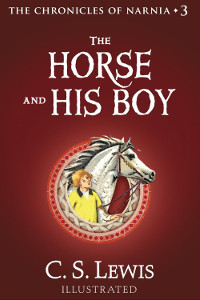
Bree, the horse, has been kidnapped from Narnia and longs to return there. Shasta, on the verge of being sold into slavery, decides to run away with him in search of the home he's always dreamed of. But the journey is full of surprises and fraught with dangers, and when the companions uncover a treasonous plot, it also becomes a race against time.
It was enough of a surprise for Shasta to discover he wasn't the son of Arsheesh the fisherman. But when Bree, the talking horse, whisks him away from the cruel land of Calormen in search of the safe and happy of Narnia where High King Peter rules, Shasta finds himself up to his ears in mystery and adventure such as he could never imagine in his wildest dreams. Their journey is charged with fear and danger, intrigue and adventure, as they make their way in disguise through the city of Tashbaan, past the eerie tombs, then on by burning day and silvery night over the harsh desert to the high mountains of Archenland. Even when Narnia is in sight, Shasta realises he must finally conquer his fear. "If you funk this," he tells himself, "you'll funk every battle in your life. Now or never."
Much debate over whether this is the third in the Narnia series, with Prince Caspian always considered being the direct sequel, but with the 4 children appearing as kings and queens in Narnia in the novel and happening in that timeline I think it is safe to include it as the official third book in the Chronicles Of Narnia series.
The Horse & His Boy takes place in a different place of Narnia during the reign of the The Pevensies as adults. The story starts in Calormen, an arid land far to the south of Cair Paravel. Slavery is a part of life in Calormen and a young boy named Sasha meets a talking Narnian horse named Bree. Together they decide to escape and head to Narnia where, due to Sasha's fair complexion, he should be able to pass as native and escape his life of servitude.
After a little nudge from Aslan they meet Aravis and her horse Hwin who are escaping her arranged marriage. Together they agree to travel to Narnia and seek refuge under the Pevensies rule.
The problem with getting to Narnia is that they have to pass through the Calormine capital Tashbaan. Upon entering the congested city the two become separated and Sasha, who bears an uncanny resemblance to the Tashbaan prince, is mistaken by Queen Susan and King Edmund. Sasha overhears the Queen and King planning to escape the city as Susan does not want to marry the cruel prince.
Meanwhile Avris runs into her own problems when she is recognized by one of her wealthy friends. Convincing her spoiled and selfish friend that she must escape the palace and her planned marriage is an entertaining read. Avris overhears the Prince's plan to invade Narnia in relation to Queen Susan's escape.
Sasha and Avris manage to escape the city and head for Narnia with their horses, fighting Rabadash's army the whole way and must get to Narnia in time to warn the Kings and Queens.
The Horse And His Boy is the most mature and adventurous novel of the Narnian series. This is the novel that makes Narnia seem like a real and large country. A clear inspiration for this was the Arabian Nights legends and this drips through in Lewis's imagery of the desert cities.
The pacing and narrative are a complete departure from every other Narnian story. This is clearly aimed at an older teenager audience and is a adventure story. There is also a lot less magic for obvious reasons and a brief appearance from Aslan to help guide the armies in the right direction keeps things Narnian.
The Horse And His Boy is an exciting adventure through a different part of Narnia, telling a different kind of story that shows what a true genius CS Lewis, showcasing just how real Narnia was as a country.
- Buy on Amazon
Review by Alaisdair Dewar
6 positive reader review(s) for The Horse And His Boy
CS Lewis biography
The Chronicles of Narnia
- The Magician's Nephew (The Chronicles of Narnia: Book 1)
- The Lion The Witch And The Wardrobe (The Chronicles of Narnia: Book 2)
- The Horse And His Boy (The Chronicles of Narnia: Book 3)
- Prince Caspian (The Chronicles of Narnia: Book 4)
- The Voyage of the Dawn Treader (The Chronicles of Narnia: Book 5)
- The Silver Chair (The Chronicles of Narnia: Book 6)
- The Last Battle (The Chronicles of Narnia: Book 7)
Gina from America
This is the best Narnia book out there. It's quick and easy to read because it has an engaging plot. The character of Aravis is a strong female character and there is no racism! Just because some people with brown skin in this book are evil doesn't mean C. S Lewis said that all people with brown skin are bad. In fact there is the Tisroc, who is a cruel yet wise leader, Rabadash, who is a hothead, Aravis, who is brave, proud, loyal, and stubborn, Lasareen, a loyal friend who is vain, and that guy who Aravis was going to marry, an old weasle who has no pride. There are many different types of character with brown skin and only 1 out of 5 is a bad guy. A main good guy has brown skin. Nevertheless this is a great book and a must read.
Daniel from Israel
A surprisingly great Narnian adventure set in the times of the end of “The lion, the witch and the wardrobe”. The characters are great and well-rounded, the adventures and landscapes are awesome and story is just great and captivating. The Christian subtexts and educational parts are a bit more subtle than previous books, yet still the racism start to be more apparent. The Calormenes are undoubtedly Muslims and undoubtedly savage and wicked, but all in all the strength of the story succeeds to win you over and remain an amazing read.
Kristen from US
Good review but, the names were spelt wrong and that kinda bothered me but, great other than that!
Owen from United States
The best book among the chronicles.
David from US
This is a good book.
Makaila from Los Angeles
I really loved this book like no words to describe it.
Tom from Nebraska
I treat this book as #3 in the Chronicles and it has a very different feel to the other books in the series. Set at a time following the events of The Lion, The Witch and the Wardrobe we find King Peter on the throne. But this story is Shasta's, an orphan running away from a fisherman's life with help from a talking horse named Bree. They encounter numerous adventures on their quest to reach Narnia and it makes for a great book to read to children as it is full of adventure and shows Narnian lands not previously seen. When C. S. Lewis is telling a story and not preaching he is a real force to be reckoned with, writing humorous, involving plots with engaging characters. Recommended.
8.9 /10 from 8 reviews
All CS Lewis Reviews

Top 100 Fantasy Books Of All Time
Looking for great fantasy books? Take a look at the 100 pages we rate highest

Fantasy Series We Recommend
There's nothing better than finding a fantasy series you can lose yourself in

Fantasy Books Of The Year
Our fantasy books of the year, from 2006 to 2021

- Ask LitCharts AI
- Discussion Question Generator
- Essay Prompt Generator
- Quiz Question Generator

- Literature Guides
- Poetry Guides
- Shakespeare Translations
- Literary Terms
The Horse and His Boy
C. s. lewis.

Ask LitCharts AI: The answer to your questions
Shasta is a boy who lives in the southern part of the country of Calormen. His adoptive father, Arsheesh , is a poor fisherman who found Shasta on a boat when Shasta was an infant. One day, a Tarkaan (lord) rides into Shasta’s small town and starts negotiating with Arsheesh to purchase Shasta and enslave him. While this negotiation is happening, Shasta comes upon the Tarkaan’s horse and discovers to his surprise that the horse can talk. Bree , the Talking Horse, warns Shasta that the Tarkaan is a cruel man, and together, the two of them sneak away, heading north toward Narnia, where Bree promises people live freely without slavery.
At one point in their journey, Shasta and Bree get chased by lions . In their efforts to get away, they run into Aravis , a Tarkheena (Calormen noblewoman) who is trying to escape an unwanted marriage, and her Talking Horse, Hwin . The four of them decide to travel together.
When the group reaches the city of Tashbaan , Shasta, Aravis, and their horses all decide to disguise themselves as peasants to avoid detection in the city crowds. They make a plan to meet on the far side of the city if they get separated, and sure enough, Shasta gets pulled away from the others by some men while they’re all attempting to get through the city. It turns out that several Narnians have mistaken Shasta for Corin , a prince who looks almost exactly like Shasta. Shasta keeps up the ruse as he meets Queen Susan and King Edmund , two of the four sibling monarchs of Narnia. The monarchs have become trapped in Tashbaan, where the local Prince Rabadash intends to marry Susan, by force if necessary. Eventually, the real Corin returns to take back his place, Shasta makes his way to the meeting place, and Susan and Edmund escape the city by boat.
Meanwhile, Aravis has a chance meeting with her friend Lasaraleen , and over the course of their conversation Aravis realizes how different she has become from many of the other Calormenes, even her old friends. She finally gets away to rejoin Shasta by the Tombs to the north of the city.
After discovering Susan’s escape, Prince Rabadash declares to his father, the Tisroc (emperor) of Calormen, that he will ride across the desert into Narnia with 200 men and take Susan back. The Tisroc allows him to go, so long as he pretends to be acting independently, without the Tisroc’s approval. Rabadash’s plan is to start with a siege of Anvard, the castle where King Lune , the king of Archenland, lives. When Shasta and Aravis learn of this plan, they set off at once to try to reach King Lune and warn him.
During their rush to find King Lune, the party gets attacked by a lion. Although Bree behaves cowardly and gallops away to save himself, Shasta bravely turns back to stop the lion from attacking Aravis and Hwin. They all go to a Hermit who helps tend to Aravis and Hwin’s wounds. Shasta continues his journey alone and reaches King Lune, where he explains the coming attack. Shasta then rides with King Lune back to Anvard on an unfamiliar horse, but the horse is slow, and Shasta gets left behind in a dense fog. In the fog, Shasta meets a large invisible creature who reveals himself to be the Talking Lion Aslan . Aslan says he has been watching over Shasta’s journey the whole time. When the fog clears and Aslan is gone, Shasta has apparently crossed through a mountain pass into Narnia without realizing it.
In Narnia, Shasta meets up with a party that includes Edmund, Lucy , and Corin, who are all traveling toward Anvard to stop Rabadash’s attack. A great battle ensures (which the Hermit watches from a distance), and with the help of Shasta and the Narnians, the army of Archenland totally defeats Rabadash and his army.
After the battle, everyone debates what to do with the captured Rabadash. Aslan appears again and curses Rabadash by turning him into a donkey. He tells Rabadash that he must travel back to a temple in his homeland, and if he ever strays too far from that temple, he’ll turn back into a donkey forever. Rabadash spends the rest of his life in Calormen and develops a reputation for being unintelligent.
Meanwhile, Shasta learns that the reason why he looks so much like Corin is that he’s actually Corin’s twin brother (and King Lune’s son), Cor. Cor was kidnapped and set adrift at sea as a baby as part of a conspiracy. Now, Cor returns to his rightful place as the heir to King Lune’s throne. He marries Aravis and goes on to have a successful reign after the death of his father. Bree and Hwin settle in Narnia, but they continue to come back frequently to visit Cor and Aravis in Archenland.

- Quizzes, saving guides, requests, plus so much more.
| < | > | > |
The Horse and His Boy
by C.S. Lewis
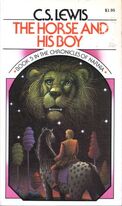
| Illustrator: | Pauline Baynes |
| Series: | Chronicles of Narnia #5 |
| Publisher: | Collier Books |
| Copyright: | 1954 |
| Printing: | 1978 |
| ISBN: | 0-02-044200-9 |
| Format: | Mass market |
| Pages: | 217 |
The Horse and His Boy was the fifth published book in the Chronicles of Narnia, but it takes place during the last chapter of The Lion, the Witch and the Wardrobe , in the midst of the golden age of Narnia. It's the only true side story of the series and it doesn't matter much where in sequence you read it, as long as it's after The Lion, the Witch and the Wardrobe and before The Last Battle (which would spoil its ending somewhat).
MAJOR SPOILERS BELOW .
The Horse and His Boy is also the only book of the series that is not a portal fantasy. The Pevensie kids make an appearance, but as the ruling kings and queens of Narnia, and only as side characters. The protagonists are a boy named Shasta, a girl named Aravis, and horses named Bree and Hwin. Aravis is a Calormene, a native of the desert (and extremely Orientalist, but more on that later) kingdom to the south of Narnia and Archenland. Shasta starts the book as the theoretically adopted son but mostly slave of a Calormene fisherman. The Horse and His Boy is the story of their journey from Calormen north to Archenland and Narnia, just in time to defend Narnia and Archenland from an invasion.
This story starts with a great hook. Shasta's owner is hosting a passing Tarkaan, a Calormene lord. Shasta overhears a negotiation to sell him to the Tarkaan as a slave (and, in the process, the revelation that Shasta was rescued as an infant from a rowboat next to a dead man). Shasta starts talking to the Tarkaan's horse and is caught by surprise when the horse talks back. He is a Talking Horse from Narnia, kidnapped as a colt, and eager to return to Narnia and the North. He convinces Shasta to attempt to escape with him.
This has so much promise. For once, we're offered a story where one of the talking animals of Narnia is at least a co-protagonist and has some agency in the story. Bree takes charge of Shasta, teaches him to ride (or, mostly, how to fall off a horse), and makes most of the early plans. Finally, a story that recognizes that Narnia stories don't have to revolve around the humans!
Unfortunately, Bree is an obnoxious, arrogant character. I wanted to like him, but he makes it very hard. This gets even worse when Shasta is thrown together with Aravis, a noble Calormene girl who is escaping an arranged marriage on her own talking mare, Hwin. Bree is a warhorse, Hwin is a lady's riding mare, and Lewis apparently knows absolutely nothing about horses, because every part of Bree's sexist posturing and Hwin's passive meekness is awful and cringe-worthy. I am not a horse person, so will link to Judith Tarr's much more knowledgeable critique at Tor.com , but suffice it to say that mares are not meekly deferential or awed by stallions. If Bree had behaved that way with a real mare, he would have gotten the crap beaten out of him (which might have improved his attitude considerably). As is, we have to put up with rather a lot of Bree's posturing and Hwin (who I liked much better) barely gets a line and acts disturbingly like she was horribly abused.
This makes me sad, because I like Bree's character arc. He's spent his whole life being special and different from those around him, and while he wants to escape this country and return home, he's also gotten used to being special. In Narnia, he will just be a normal talking horse. To get everything else he wants, he also has to let go of the idea that he's someone special. If Lewis had done more with this and made Bree a more sympathetic character, this could have been very effective. As written, it only gets a few passing mentions (mostly via Bree being weirdly obsessed with whether talking horses roll) and is therefore overshadowed by Shasta's chosen one story and Bree's own arrogant behavior.
The horses aside, this is a passable adventure story with some well-done moments. The two kids and their horses end up in Tashbaan, the huge Calormene capital, where they stumble across the Narnians and Shasta is mistaken for one of their party. Radagast, the prince of Calormen, is proposing marriage to Susan, and the Narnians are in the process of realizing he doesn't plan to take no for an answer. Aravis, meanwhile, has to sneak out of the city via the Tisroc's gardens, which results in her hiding behind a couch as she hears Radagast's plans to invade Archenland and Narnia to take Susan as his bride by force. Once reunited, Shasta, Aravis, and the horses flee across the desert to bring warning to Archenland and then Narnia.
Of all the Narnia books, The Horse and His Boy leans the hardest into the personal savior angle of Christianity. Parts of it, such as Shasta's ride over the pass into Narnia, have a strong "Footprints" feel to them. Most of the events of the book are arranged by Aslan, starting with Shasta's early life. Readers of the series will know this when a lion shows up early to herd the horses where they need to go, or when a cat keeps Shasta company in the desert and frightens away jackals. Shasta only understands near the end.
I remember this being compelling stuff as a young Christian reader. This personal attention and life shaping from God is pure Christian wish fulfillment of the "God has a plan for your life" variety, even more so than Shasta turning out to be a lost prince. As an adult re-reader, I can see that Lewis is palming the theodicy card rather egregiously. It's great that Aslan was making everything turn out well in the end, but why did he have to scare the kids and horses half to death in the process? They were already eager to do what he wanted, but it's somehow inconceivable that Aslan would simply tell them what to do rather than manipulate them. There's no obvious in-story justification why he couldn't have made the experience much less terrifying. Or, for that matter, prevent Shasta from being kidnapped as an infant in the first place and solve the problem of Radagast in a more direct way. This sort of theology takes as an unexamined assumption that a deity must refuse to use his words and instead do everything in weirdly roundabout and mysterious ways, which makes even less sense in Narnia than in our world given how directly and straightforwardly Aslan has acted in previous books.
It was also obvious to me on re-read how unfair Lewis's strict gender roles are to Aravis. She's an excellent rider from the start of the book and has practiced many of the things Shasta struggles to do, but Shasta is the boy and Aravis is the girl, so Aravis has to have girl adventures involving tittering princesses, luxurious baths, and eavesdropping behind couches, whereas Shasta has boy adventures like riding to warn the king or bringing word to Narnia. There's nothing very objectionable about Shasta as a character (unlike Bree), but he has such a generic character arc. The Horse and Her Girl with Aravis and Hwin as protagonists would have been a more interesting story, and would have helpfully complicated the whole Narnia and the North story motive.
As for that storyline, wow the racism is strong in this one, starting with the degree to which The Horse and His Boy is deeply concerned with people's skin color. Shasta is white, you see, clearly marking him as from the North because all the Calormenes are dark-skinned. (This makes even less sense in this fantasy world than in our world because it's strongly implied in The Magician's Nephew that all the humans in Calormen came from Narnia originally.) The Calormenes all talk like characters from bad translations of the Arabian Nights and are shown as cruel, corrupt slavers with a culture that's a Orientalist mishmash of Arab, Persian, and Chinese stereotypes. Everyone is required to say "may he live forever" after referencing the Tisroc, which is an obvious and crude parody of Islam. This stereotype fest culminates in the incredibly bizarre scene that Aravis overhears, in which the grand vizier literally grovels on the floor while Radagast kicks him, and the Tisroc, Radagast's father, talks about how Narnia's freedom offends him and the barbarian kingdom would be more profitable and orderly when conquered.
The one point to Lewis's credit is that Aravis is also Calormene, tells stories in the same style, and is still a protagonist and just as acceptable to Aslan as Shasta is. It's not enough to overcome the numerous problems with Lewis's lazy world-building, but it makes me wish even more that Aravis had gotten her own book and more meaningful scenes with Aslan.
I had forgotten that Susan appears in this book, although that appearance doesn't add much to the general problem of Susan in Narnia except perhaps to hint at Lewis's later awful choices. She is shown considering marriage to the clearly villainous Radagast, and then only mentioned later with a weird note that she doesn't ride to war despite being the best archer of the four. I will say again that it's truly strange to see the Pevensie kids as (young) adults discussing marriage proposals, international politics, and border wars while remembering they all get dumped back into their previous lives as British schoolkids. This had to have had dramatic effects on their lives that Lewis never showed. (I know, the real answer is that Lewis is writing these books according to childhood imaginary adventure logic, where adventures don't have long-term consequences of that type.)
I will also grumble once more at how weirdly ineffectual Narnians are until some human comes to tell them what to do. Calormen is obviously a threat; Susan just escaped from an attempted forced marriage. Archenland is both their southern line of defense and is an ally separated by a mountain pass in a country full of talking eagles, among other obvious messengers. And yet, it falls to Shasta to ride to give warning because he's the human protagonist of the story. Everyone else seems to be too busy with quirky domesticity or endless faux-medieval chivalric parties.
The Horse and His Boy was one of my favorites when I was a kid, but reading as an adult I found it much harder to tolerate Bree or read past the blatant racial and cultural stereotyping. The bits with Aslan also felt less magical to me than they did as a kid because I was asking more questions about why Aslan had to do everything in such an opaque and perilous way. It's still not a bad adventure; Aravis is a great character, the bits in Tashbaan are at least memorable, and I still love the Hermit of the Southern March and want to know more about him. But I would rank it below the top tier of Narnia books, alongside Prince Caspian as a book with some great moments and some serious flaws.
Followed in original publication order by The Magician's Nephew .
Rating: 7 out of 10
Reviewed: 2021-05-31
Stray Thoughts
A home for the stray thoughts of an ordinary christian woman.

Book Review: The Horse and His Boy

I read The Horse and His Bo y by C. S. Lewis for the Chronicles of Narnia Reading Challenge and the book club choice for July sponsored by Carrie at Reading to Know .

But Shasta had never heard of Narnia. Shasta was a boy living in Calormen with a poor fisherman whom he called his father. When a stranger arrived to lodge with them, Shasta listened at the door while the stranger bargained with the fisherman about buying Shasta! Shasta was shocked, but relieved, for he had felt uneasy about not really loving the fisherman as a father.
Shasta strolled out to where the stranger’s horse was grazing to think over his predicament, only to discover that the horse is a talking horse from Narnia named Bree. Bree convinced Shasta that they must both escape to Narnia.
On their way they encountered another escapee, Aravis, on another talking horse, Hwin. Aravis was proud daughter of a lord of Calavar and is escaping an arranged marriage.
They had to go through a great city, but in the process Shasta was absconded by a group of Narnians who mistook him for someone else while Aravis recognized a friend and hid away with her. Through these situations they learned the best way to get across the desert, but they also learned of a planned attack on a neighboring city of Narnia. When they met up again, they hasten on to Narnia now not just for their own reasons, but to warn them of attack.
I had read the whole Chronicles of Narnia some time ago, but I didn’t remember much of anything about this story. And while I wouldn’t say it’s a favorite story of the series, I love the richness of the themes.
One obvious theme is identity. Shasta discovers he is not who he always thought he was and exclaims, “Why, I could be anybody!” He’s even more surprised when he does learn who he actually is. Bree and Hwin could not express their true and full identity while in captivity. Aravis has to hide her identity to escape, and when she meets up with her friend she sees her former lifestyle in a new light. Rabadash, the proud, jilted prince who leads the attack against Narnia’s neighbor as a foothold toward Narnia itself, becomes in form like the identity he’s portraying. And when Aslan identifies himself to Shasta, Shasta is “no longer afraid” that he would harm him, “but a new and different sort of trembling came over him. Yet he felt glad too.”
Another theme is finding one’s true homeland (Bekah develops this theme beautifully here in Groping for another lan d.)
A third theme echoes many Biblical admonitions that those who humble themselves will be exalted and those who exalt themselves will be humbled. Shasta comes from a humble background yet Aravis later has to admit, “I’ve been snubbing him and looking down on him…and now he turns out to be the best of us all.” Aravis has to take responsibility for her actions and determines “I think it would be better to stay and say we’re sorry than to go back.” Bree realizes his proud folly as well, but at first holds back, being almost too proud in his abasement to go forward. The Hermit tells him. “But as long as you know you’re nobody special, you’ll be a very decent sort of Horse, on the whole.” Rabadash refuses to humble himself and faces the consequences.
Still another theme is Providence (which I didn’t know when I started the book, but it dovetails nicely with my concurrent reading of Not By Chance: Learning to Trust a Sovereign God by Layton Talbert. I’ve just finished that except for one appendix and hope to review it later this week.) When Aravis remarks to the hermit she has taken refuge with that she’s had luck, he remarks, “I have now lived a hundred and nine winters in this world and have never yet met with any such thing as Luck.” When all the characters meet up with Aslan, they learn he had been with them, watching over them, guiding circumstances. Shasta’s situation, in fact, is reminiscent of Joseph’s in the Bible, being sent ahead to later save others. Related to Aslan’s providence towards individuals is his repeated admonition that he tells each one no story but their own when they ask about what’s going on in other people’s lives. And when Shasta is telling the story of how he came to be in Calormen, he remarks that Aslan “seems to be at the back of all the stories.”
This is one of those books that has me still thinking, making connections, realizing themes and truths long after the book is closed. And that’s one mark of a good book.
__________________
Instead of writing a separate wrap-up post for the end of the Narnia challenge tomorrow, I’ll just wrap it up here by saying I also read The Silver Chair (linked to my thoughts) for this year’s challenge. I always enjoy breathing Narnian air and look forward to finishing up the last two books of the series next year.
Previous Narnia-related posts are:
The Lion, the Witch, and the Wardrobe .
Prince Caspian .
Voyage of the Dawn-Treader .
The Lion, the Witch, and the Wardrobe Graphic Novel .
Narnian Magic (not a book, but a hammering out of my thoughts on the use of magic in the series.)
(This review will also be linked to Semicolon ‘s Saturday Review of Books .)

Share this:
8 thoughts on “ book review: the horse and his boy ”.
“This is one of those books that has me still thinking, making connections, realizing themes and truths long after the book is closed. And that’s one mark of a good book.”
Totally agree. The Narnia books do that for me. too. Love “breathing Narnian air.”
One of these days, I might find time to read some of these.
If you ever get a chance to hear the Focus on the Family dramatized versions of these stories, I think you’ll enjoy them. ‘The Horse and His Boy’ has long been a favorite of mine. You’re right about all the ways it makes you think long after the book is closed.
I really appreciated how you picked up on the theme of humility. I hadn’t noticed it before, but now that you mention it, I can see it throughout the story. You and I certainly did identify some similar themes, though!
I have to kinda laugh at how different my perception of The Horse and His Boy is as an adult as opposed to as a kid. When I was young, I wasn’t particularly fond of this book, but loved and read and re-read the scene where Rabadash turns into a donkey. Now, I’m becoming much more fond of the book–and find Rabadash’s transformation to be achingly sad.
Pingback: What’s On Your Nightstand: August 2012 « Stray Thoughts
This one was not one of my favorites as a child, but re-reading the series as an adult, I found I really liked this one. It has a perfect plot arc and I love that the biblical imagery and themes are part of the story instead of the story existing for the biblical imagery. It also spoke a lot to me in the time I read it, especially the part where Shasta asks Aslan why he wounded Aravis and Aslan tells him it’s not for him to know because it’s her story, not his. Love it.
Pingback: Books Read in 2012 « Stray Thoughts
Pingback: Book Review: The Last Battle | Stray Thoughts
Comments are closed.
- Already have a WordPress.com account? Log in now.
- Subscribe Subscribed
- Copy shortlink
- Report this content
- View post in Reader
- Manage subscriptions
- Collapse this bar
The Horse And His Boy
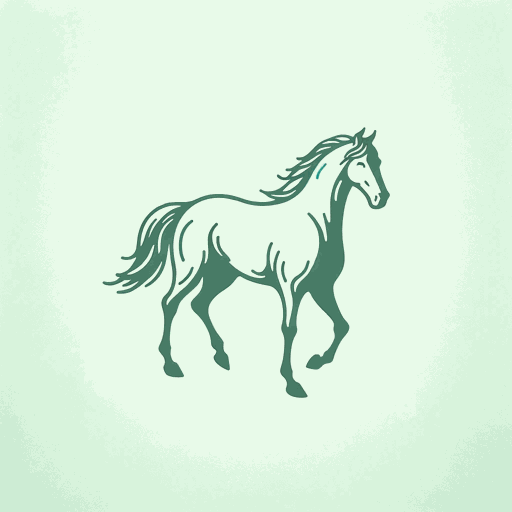
48 pages • 1 hour read
A modern alternative to SparkNotes and CliffsNotes, SuperSummary offers high-quality Study Guides with detailed chapter summaries and analysis of major themes, characters, and more.
Chapter Summaries & Analyses
Chapters 1-3
Chapters 4-9
Chapters 10-15
Character Analysis
Symbols & Motifs
Literary Devices
Important Quotes
Essay Topics
Discussion Questions
Summary and Study Guide
The Horse and His Boy , published in 1954 , is the fifth of the seven books that comprise C. S. Lewis’s young readers series The Chronicles of Narnia . The first of the books, The Lion, The Witch, and the Wardrobe , was published in 1950. Lewis published an additional book in the series each year through 1956. The Horse and His Boy was published in 1954. Lewis later requested the reading order of the books be changed so that The Horse and His Boy became the third entry in the series.
Lewis intended his fantasy novels to introduce Christian theology and perspectives to a generation of young readers. He wrote many additional fiction and nonfiction books that were meant to expound Christianity for adult readers. Readers should be advised that The Horse and His Boy depicts death in battle, slavery, and problematic depictions of people who might be characterized as Arab or Middle Eastern—though the novel is set in a fantasy realm. There are several occasions in which characters drink wine. This summary uses the 2002 Harper Collins edition of the text.
Plot Summary
Shasta, a boy being raised in isolation by a coastal fisherman named Arsheesh in the mythical land of Calormen. Shasta knows that his appearance (fair hair and skin) set him apart from those around him. He would like to know more about the wider world. Arsheesh, however, punishes him for asking too many questions, particularly about the mysterious northern lands.
When a visiting Tarkaan—Calormene nobleman—insists on a night’s hospitality, Shasta overhears his conversation with Arsheesh. He learns he is not the Arsheesh’s son ,and the Tarkaan intends to buy him. As Shasta muses aloud in the stable, the Tarkaan’s horse introduces himself as Bree , a horse kidnapped from the land of Narnia. He has been looking for a means of escaping to his homeland. Bree proposes the two of them run away to Narnia.
They escape by pretending to head south, the direction in which Bree’s Tarkaan lives, then turning north. As they approach Tashbaan, they meet another horse and human pair, a royal Calormen girl named Aravis , and a horse named Hwin . They discover they are all bound for Narnia and decide to travel there together.
The four travelers make their way to Tashbaan. They agree to meet on the far side of the city if they become separated.
As they approach the city, a group of foreigners see Shasta and mistake him for Corin, a boy in their group who has gone missing. They take Shasta to a palace, where they feed him and compel him to rest, believing he is overcome with the heat. Shasta learns they are Narnians visiting Tashbaan so one of their queens, Susan, can consider the marriage proposal of Rabadash, the crown prince of Calormen. Susan has decided that she will refuse his proposal.
Susan’s brother, King Edmund, has heard that their group will be captured if Susan refuses. They discuss Rabadash’s underlying goals and try to decide how to escape. Shasta falls asleep and is awakened by someone climbing the outside wall into the stateroom. It is his double, Corin, for whom the Narnian’s had mistaken him. Corin tells Shasta how to escape from the palace.
Shasta eventually reunited with Aravis, who has learned of Rabadash’s plan to take 200 cavalrymen through the Archenland capital of Anvard and on to Narnia to kidnap Susan. On their way to the north, they are chased by a lion. Then they meet the Hermit of the Southern March, who instructs Shasta to run out the other side of the enclosure toward Anvard so he can warn King Lune about Rabadash.
Shasta runs toward Anvard and encounters the hunting party of King Lune, who assumes Shasta is Corin. Shasta warns them of Rabadash. They provide a horse for Shasta and gallop toward Anvard. Shasta is distanced and eventually lost in fog. He overhears Rabadash counseling his soldiers to kill all the males in Anvard. Riding higher up the mountain, Shasta is aware someone is walking beside him. Aslan , the lion, speaks, explains how he has been with Shasta from the beginning.
The Narnians eventually defeat and capture Rabadash. Aslan departs and Shasta, now recognized as Prince Cor, Corin’s twin kidnapped in infancy, arrives with an entourage, to escort the travelers to Anvard, where Aravis will become the lady of the court. Aslan turns Rabadash into a donkey. Cor will become the king of Archenland, marry Aravis, and their son Ram will become the country’s great king. Bree and Hwin return to Narnia.

Related Titles
By C. S. Lewis
A Grief Observed
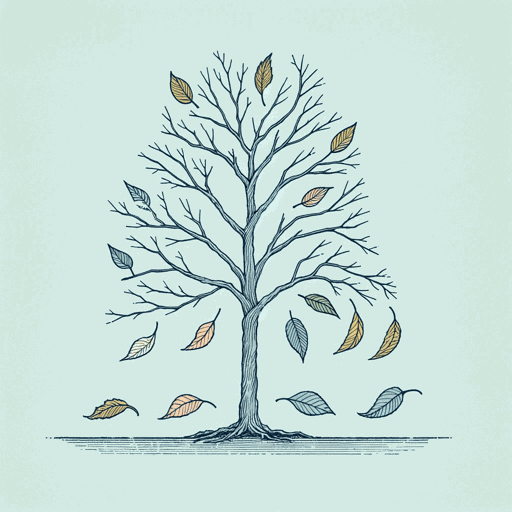
Mere Christianity

Out of the Silent Planet

Prince Caspian
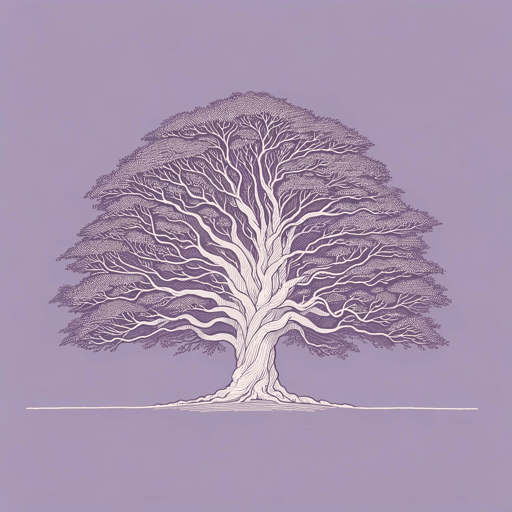
Surprised by Joy

That Hideous Strength
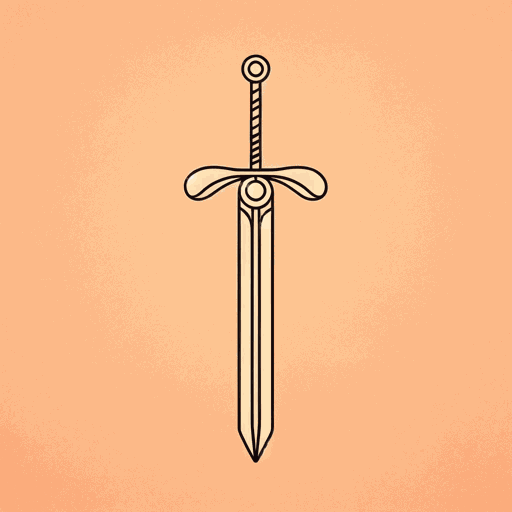
The Abolition of Man

The Discarded Image

The Four Loves

The Great Divorce
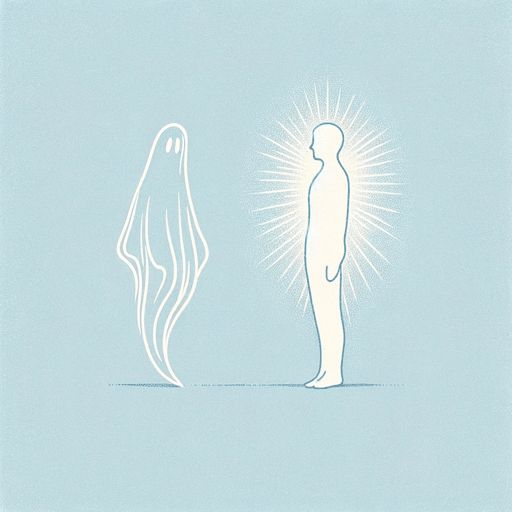
The Last Battle
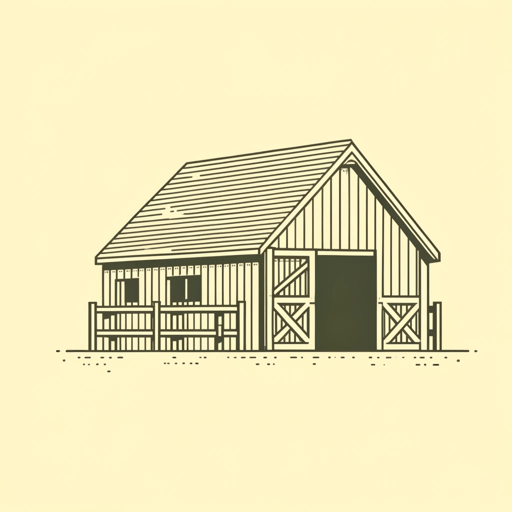
The Lion, the Witch and the Wardrobe
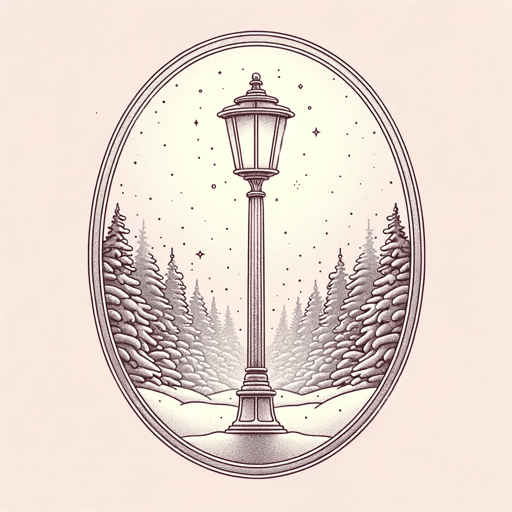
The Magician's Nephew

The Pilgrim's Regress

The Problem of Pain
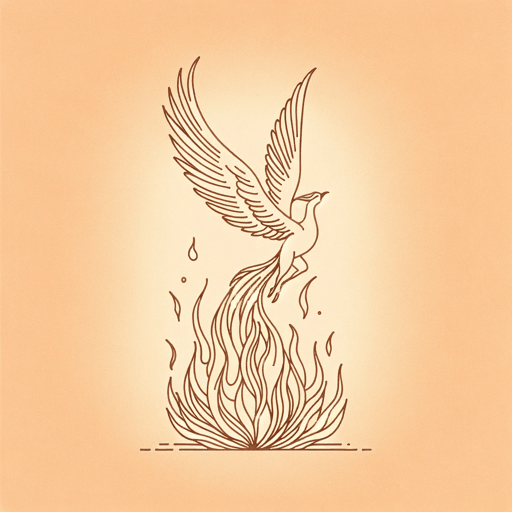
The Screwtape Letters

The Silver Chair

The Voyage of the Dawn Treader

Till We Have Faces

by C. S. Lewis
These notes were contributed by members of the GradeSaver community. We are thankful for their contributions and encourage you to make your own.
Written by justice cooper, Buland Iqbal and other people who wish to remain anonymous
The story revolves around a young Calormene by the name of Shasta . Shasta and his father, Arsheesh, live life as fishermen. However, one day Shasta discovers that Arsheesh is not his real father and intends to sell him to a cruel nobleman by the name of Anradin. Shasta does not know this initiative and thus is prepared to be sold. However, Anradin's horse, Bree , is a talking Narnian horse who Shasta meets. Bree tells him that Anradin will treat him viciously and that the two should attempt running away to Narnia. Shasta agrees and the two run away. They meet another escapee, Aravis , and her horse Hwin, who is fleeing a forced marriage to Ahoshta.
They travel to Tashbaan, which is the Calormen capital, and here they see a group of Narnians who assume that Shasta is Corin , a prince from Archenland. Shasta pretends to be the prince and thus hears talk of their plot to leave Calormen to prevent the marriage of Queen Susan to Rabadash , the Tisroc's son.
Aravis also wants to escape Tashbaan and recruits her friend, Lasaraleen 's help in doing so. During their escape, they overhear Tisroc, Rabadash, and Ahoshta who agree that they will enter Narnia to seize Queen Susan whilst High King Peter's attention is diverted fighting giants. Aravis and Shasta meet again, where she reveals to him of the plot. They begin escaping Rabadash's men, and a large lion appears, yet they do not know it is indeed Aslan and scares them into outrunning the Calormen.
Shasta arrives in Archenland and warns them of the attack. The Calormens arrive and a battle ensues. Queen Lucy and King Edmund arrive with a relief party to help the war effort, and Rabadash is captured whilst Anradin is killed in the effort. Aslan transforms Rabadash to a donkey and tells him that he will continuously transform into a donkey if he travels ten miles from the Temple of Tash. Thus, he allows Rabadash to become Tisroc as he knows that he cannot pursue any wars as he would transform into a donkey if he travels more than ten miles. Shasta is then identified as the long-lost twin brother of Prince Corin. He accepted by Narnian's and eventually marries Aravis and they have a son named Ram, who becomes the King.
Update this section!
You can help us out by revising, improving and updating this section.
After you claim a section you’ll have 24 hours to send in a draft. An editor will review the submission and either publish your submission or provide feedback.

The Horse and His Boy Questions and Answers
The Question and Answer section for The Horse and His Boy is a great resource to ask questions, find answers, and discuss the novel.
How does the lion direct Shasta and Arvis and both the horses to where they need to go to meet?why do you think Asian forces them together?
What chapter are you referring to?
The Horse and His Boy
The Narnians escape to the garden gate with the help of Aravis. Shasta is supposed to be waiting for them in the tombs.
How does Bree help Shsta develop and grow
Shasta is young man who was kidnapped at birth and sold into Calormene slavery who over the course of the book plans to escape from his abusive master with the help of a talking horse named Bree. It is revealed that Shasta is actually Cor, the...
Study Guide for The Horse and His Boy
The Horse and His Boy study guide contains a biography of C. S. Lewis, literature essays, quiz questions, major themes, characters, and a full summary and analysis.
- About The Horse and His Boy
- Character List
Wikipedia Entries for The Horse and His Boy
- Introduction

- [ July 17, 2024 ] Tumnus’ Bookshelf: The NarniaFans Book Reviews: Once a Queen by Sarah Arthur Miscellaneous
- [ May 31, 2024 ] Tom Bombadil Sings His Way Into The Rings of Power! J.R.R. Tolkien
- [ May 14, 2024 ] The Rings of Power returns with Season 2! Here’s the teaser! The Lord of the Rings
- [ April 8, 2024 ] Through a New Wardrobe: The NarniaFans Interview Series: Uncovering Once a Queen with Sarah Arthur Part 1of 2. Interviews
- [ April 2, 2024 ] APRIL FOOLS 2024! April Fool's Day
The Horse and His Boy
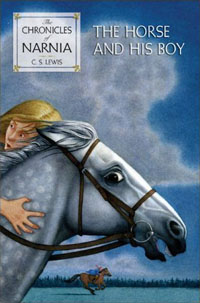
Publication Date: 1954
A WILD GALLOP FOR FREEDOM
Dedication: To David and Douglas Gresham
Summary: Narnia … where some horses talk … where treachery is brewing … where destiny awaits.On a desperate journey, two runaways meet and join forces. Though they are only looking to escape their harsh and narrow lives, they soon find themselves at the center of a terrible battle. It is a battle that will decide their fate and the fate of Narnia itself.
Characters of The Horse and His Boy
- Lucy Pevensie
- Breehy-hinny-brinny-hoohy-hah
- Aravis Tarkheena
- Prince Corin
- Lasaraleen Tarkheena
- Hermit of the Southern March
- Bricklethumb
- Chervy the Stag
- Lapsed Bear of Stormness
- Kidrash Tarkaan
- Peter Pevensie
- Susan Pevensie
- Edmund Pevensie
Chapter Summaries
- How Shasta Set Out On His Travels
- A Wayside Adventure
- At the Gates of Tashbaan
- Shasta Falls In With The Narnians
- Shasta Among the Tombs
- Aravis in Tashbaan
- In the House of the Tisroc
- Across the Desert
- The Hermit of the Southern March
- The Unwelcome Fellow Traveller
- Shasta in Narnia
- The Fight at Anvard
- How Bree Became a Wiser Horse
- Rabadash the Ridiculous
Be the first to comment
Leave a reply cancel reply.
Your email address will not be published.
Save my name, email, and website in this browser for the next time I comment.
Copyright © NarniaFans.com
- Children's Books
- Literature & Fiction

Sorry, there was a problem.

Download the free Kindle app and start reading Kindle books instantly on your smartphone, tablet, or computer - no Kindle device required .
Read instantly on your browser with Kindle for Web.
Using your mobile phone camera - scan the code below and download the Kindle app.

Image Unavailable

- To view this video download Flash Player
Follow the authors

The Horse and His Boy Paperback – March 5, 2002
A mass-market paperback edition of The Horse and His Boy , book three in the classic fantasy series, The Chronicles of Narnia , featuring cover art by Cliff Nielsen and black-and-white interior artwork by the original illustrator of Narnia, Pauline Baynes.
On a desperate journey, two runaways meet and join forces. Though they are only looking to escape their harsh and narrow lives, they soon find themselves at the center of a terrible battle. It is a battle that will decide their fate and the fate of Narnia itself.
The Horse and His Boy is the third book in C. S. Lewis's classic fantasy series, which has been drawing readers of all ages into a magical land where horses talk and destiny awaits for over sixty years. This is a novel that stands on its own, but if you would like to explore more of Narnia, read Prince Caspian , the fourth book in The Chronicles of Narnia .
- Book 3 of 7 Chronicles of Narnia
- Print length 256 pages
- Language English
- Grade level 3 - 6
- Lexile measure 970L
- Dimensions 4.19 x 0.51 x 6.75 inches
- Publisher HarperCollins
- Publication date March 5, 2002
- ISBN-10 0064471063
- ISBN-13 978-0064471060
- See all details
Editorial Reviews
From the back cover.
A mass-market paperback edition of The Horse and His Boy , book three in the classic fantasy series, The Chronicles of Narnia , featuring cover art by Cliff Nielsen and black-and-white interior artwork by the original illustrator of Narnia, Pauline Baynes.
The Horse and His Boy is the third book in C. S. Lewis's classic fantasy series, which has been drawing readers of all ages into a magical land where horses talk and destiny awaits for over sixty years. This is a novel that stands on its own, but if you would like to explore more of Narnia, read Prince Caspian , the fourth book in The Chronicles of Narnia .
About the Author
Clive Staples Lewis (1898-1963) was one of the intellectual giants of the twentieth century and arguably one of the most influential writers of his day. He was a Fellow and Tutor in English Literature at Oxford University until 1954, when he was unanimously elected to the Chair of Medieval and Renaissance Literature at Cambridge University, a position he held until his retirement. He wrote more than thirty books, allowing him to reach a vast audience, and his works continue to attract thousands of new readers every year. His most distinguished and popular accomplishments include Out of the Silent Planet , The Great Divorce , The Screwtape Letters , and the universally acknowledged classics The Chronicles of Narnia. To date, the Narnia books have sold over 100 million copies and have been transformed into three major motion pictures.
Clive Staples Lewis (1898-1963) fue uno de los intelectuales más importantes del siglo veinte y podría decirse que fue el escritor cristiano más influyente de su tiempo. Fue profesor particular de literatura inglesa y miembro de la junta de gobierno en la Universidad Oxford hasta 1954, cuando fue nombrado profesor de literatura medieval y renacentista en la Universidad Cambridge, cargo que desempeñó hasta que se jubiló. Sus contribuciones a la crítica literaria, literatura infantil, literatura fantástica y teología popular le trajeron fama y aclamación a nivel internacional. C. S. Lewis escribió más de treinta libros, lo cual le permitió alcanzar una enorme audiencia, y sus obras aún atraen a miles de nuevos lectores cada año. Sus más distinguidas y populares obras incluyen Las Crónicas de Narnia, Los Cuatro Amores, Cartas del Diablo a Su Sobrino y Mero Cristianismo .
Product details
- Publisher : HarperCollins; Reprint edition (March 5, 2002)
- Language : English
- Paperback : 256 pages
- ISBN-10 : 0064471063
- ISBN-13 : 978-0064471060
- Reading age : 8 - 11 years, from customers
- Lexile measure : 970L
- Grade level : 3 - 6
- Item Weight : 2.31 pounds
- Dimensions : 4.19 x 0.51 x 6.75 inches
- #246 in Children's Classics
- #279 in Children's Fantasy & Magic Books
- #349 in Children's Action & Adventure Books (Books)
About the authors
Pauline baynes.
Discover more of the author’s books, see similar authors, read author blogs and more
CLIVE STAPLES LEWIS (1898-1963) was one of the intellectual giants of the twentieth century and arguably one of the most influential writers of his day. He was a fellow and tutor in English Literature at Oxford University until 1954 when he was unanimously elected to the Chair of Medieval and Renaissance English at Cambridge University, a position he held until his retirement. He wrote more than thirty books, allowing him to reach a vast audience, and his works continue to attract thousands of new readers every year. His most distinguished and popular accomplishments include Mere Christianity, Out of the Silent Planet, The Great Divorce, The Screwtape Letters, and the universally acknowledged classics, the Chronicles of Narnia. To date, the Narnia books have sold over 100 million copies and been transformed into three major motion pictures.
Customer reviews
- 5 star 4 star 3 star 2 star 1 star 5 star 75% 15% 7% 2% 1% 75%
- 5 star 4 star 3 star 2 star 1 star 4 star 75% 15% 7% 2% 1% 15%
- 5 star 4 star 3 star 2 star 1 star 3 star 75% 15% 7% 2% 1% 7%
- 5 star 4 star 3 star 2 star 1 star 2 star 75% 15% 7% 2% 1% 2%
- 5 star 4 star 3 star 2 star 1 star 1 star 75% 15% 7% 2% 1% 1%
Customer Reviews, including Product Star Ratings help customers to learn more about the product and decide whether it is the right product for them.
To calculate the overall star rating and percentage breakdown by star, we don’t use a simple average. Instead, our system considers things like how recent a review is and if the reviewer bought the item on Amazon. It also analyzed reviews to verify trustworthiness.
Customers say
Customers find the book interesting, easy to read, and hard to put down. They also appreciate the life lessons, lovely descriptions, and clear message. Readers describe the book as great for all ages. They mention the storyline is amazing and well-planned. Opinions differ on the pace, with some finding it fast and others saying it feels a bit slow to get going.
AI-generated from the text of customer reviews
Customers find the book entertaining, interesting, and adventurous. They say the writing is captivating and a good reminder of what they loved reading as a kid. Readers also mention that the book is a quick read that does not require knowledge of the subject. They also mention the book holds so much of the magic and adventure that they remember.
"...C.S. Lewis had a delightful writing style ." Read more
"These books are always entertaining . Good read" Read more
"...The Narnia books are so entertaining and interesting to read . A reader can get lost in these books as the adventure is never-ending...." Read more
"...and His Boy was written for children, it's also a book that keeps the interest of adults , who often become familiar with it by reading it to their..." Read more
Customers find the life lessons in the book important, beautiful, and spiritual. They also say it's an uplifting tale filled with doctrines and spiritual symbolism. Readers also mention that the book provides more information about the people and the lands surrounding. They describe it as a great Christian book with a good message.
"...Sword-fighting, action, adventure, good moral lessons and application are all there for the reader to enjoy and learn from...." Read more
"...The story speaks to me differently as I age. It’s got so many Christian references that I slowly start to realize as the years go by...." Read more
"...The message was clearly received and gave me much to think about from a Christian perspective...." Read more
"...A classic.In addition to a great story teller he also teaches great moral truth ." Read more
Customers find the book great for all ages.
"...this is a fine book for kids and grown ups alike !" Read more
"...It's a great read for kids and adults alike . That's why it has stood the test of time to become such a classic." Read more
"...Wonderful story of fantasy and could stand on this alone as a great childrens book ...." Read more
"The children are charming in this book , but the horses are so wonderfully developed as characters, too...." Read more
Customers find the storyline amazing, good, and exciting. They also say the ending is well-planned and classic.
"...The ending is well-planned , too...." Read more
"Adventurous and good ending to both challenge and encourage the young generation to always do the right thing and to ask for help when help is needed..." Read more
"...This is a great go-to series any time you are wanting to get immersed in a fantastical world...." Read more
"Though the history of Narnia is interesting , this book felt very tedious...." Read more
Customers find the characters in the book mysterious and come to life.
"...it’s an excellent and fun read. great story and characters . the chapter when Shasta meets Aslan was the best. Great little story." Read more
"As I remembered it...but better the second time. Always interesting names of characters and hooks to draw you into the moods that you can wander..." Read more
"...His Boy is a descriptive, well formulated story that includes some interesting characters and adds a link to the different kingdoms in his Narnian..." Read more
"Adventure to the fullest. Really good. Good persons and heroes . Good relationship with Narnia and really good action. Read if you eaten" Read more
Customers are mixed about the story pace. Some mention that the story moves fast and holds their interest, with good action. They also say the book is easy to follow and excellent in giving a timeline that was not in the movie. However, some customers feel the story feels a bit slow to get going.
"...*The Horse and His Boy* has it all. Sword-fighting, action , adventure, good moral lessons and application are all there for the reader to enjoy and..." Read more
"A good read though a little slow at times . Tells a good story and is a page turner at parts." Read more
"... It also wasn't too slow , meaning there was a very important event in the first chapter, which was when Shasta meets a talking horse, and the horse..." Read more
"The first two Narnia books were awesome. This one is very slow and drags on with boring description of various scenery...." Read more
Reviews with images

- Sort reviews by Top reviews Most recent Top reviews
Top reviews from the United States
There was a problem filtering reviews right now. please try again later..
Top reviews from other countries
- About Amazon
- Investor Relations
- Amazon Devices
- Amazon Science
- Sell products on Amazon
- Sell on Amazon Business
- Sell apps on Amazon
- Become an Affiliate
- Advertise Your Products
- Self-Publish with Us
- Host an Amazon Hub
- › See More Make Money with Us
- Amazon Business Card
- Shop with Points
- Reload Your Balance
- Amazon Currency Converter
- Amazon and COVID-19
- Your Account
- Your Orders
- Shipping Rates & Policies
- Returns & Replacements
- Manage Your Content and Devices
- Conditions of Use
- Privacy Notice
- Consumer Health Data Privacy Disclosure
- Your Ads Privacy Choices
- Election 2024
- Entertainment
- Newsletters
- Photography
- AP Buyline Personal Finance
- AP Buyline Shopping
- Press Releases
- Israel-Hamas War
- Russia-Ukraine War
- Global elections
- Asia Pacific
- Latin America
- Middle East
- Delegate Tracker
- AP & Elections
- 2024 Paris Olympic Games
- Auto Racing
- Movie reviews
- Book reviews
- Financial Markets
- Business Highlights
- Financial wellness
- Artificial Intelligence
- Social Media
Five things to know about Tim Walz
On Tuesday, Vice President Kamala Harris decided on Minnesota Gov. Tim Walz as her running mate in her bid for the White House.

Minnesota voters gathered outside Governor Tim Walz’s residence react as Walz was announced as the running mate of Kamala Harris in the U.S. presidential election. (AP Video by Mark Vancleave)

Vice President Kamala Harris has picked Minnesota Gov. Tim Walz to be her running mate, turning to a Midwestern governor, military veteran and union supporter who helped enact an ambitious Democratic agenda for his state.
FILE - Minnesota Gov. Tim Walz, right, laughs as he stands with Fridley, Minn., Mayor Scott Lund during a visit to the Cummins Power Generation Facility in Fridley, Minn., Monday, April 3, 2023. (AP Photo/Carolyn Kaster, File)
- Copy Link copied
FILE - Minnesota Gov. Tim Walz applauds as President Joe Biden speaks at Dutch Creek Farms in Northfield, Minn., Nov. 1, 2023. (AP Photo/Andrew Harnik, File)
FILE - Minnesota Gov. Tim Walz listens after meeting with President Joe Biden, July 3, 2024, at the White House in Washington. (AP Photo/Jacquelyn Martin, File)
Minnesota Gov. Tim Walz speaks during a news conference for the Biden-Harris campaign discussing the Project 2025 plan during the third day of the 2024 Republican National Convention near the Fiserv Forum, Wednesday, July 17, 2024, in Milwaukee. (AP Photo/Joe Lamberti)
FILE - Minnesota Governor Tim Walz greets reporters before Vice President Kamala Harris speaks at Planned Parenthood, March 14, 2024, in St. Paul, Minn. (AP Photo/Adam Bettcher, File)
FILE - Rep. Betty McCullum, D-Minn., left, and Minnesota Governor Tim Walz, listen as Vice President Kamala Harris speaks at Planned Parenthood, March 14, 2024, in St. Paul, Minn. (AP Photo/Adam Bettcher, File)
▶ Follow AP’s live coverage of the 2024 election
MINNEAPOLIS (AP) — Vice President Kamala Harris has decided on Minnesota Gov. Tim Walz as her running mate in her bid for the White House. The 60-year-old Democrat and military veteran rose to the forefront with a series of plain-spoken television appearances in the days after President Joe Biden decided not to seek a second term. He has made his state a bastion of liberal policy and, this year, one of the few states to protect fans buying tickets online for Taylor Swift concerts and other live events.
Some things to know about Walz:
Walz comes from rural America
It would be hard to find a more vivid representative of the American heartland than Walz. Born in West Point, Nebraska, a community of about 3,500 people northwest of Omaha, Walz joined the Army National Guard and became a teacher in Nebraska.
He and his wife moved to Mankato in southern Minnesota in the 1990s. That’s where he taught social studies and coached football at Mankato West High School, including for the 1999 team that won the first of the school’s four state championships. He still points to his union membership there.
Walz served 24 years in the Army National Guard, rising to command sergeant major, one of the highest enlisted ranks in the military, although he didn’t complete all the training before he retired so his rank for benefits purposes was set at master sergeant.
He has a proven ability to connect with conservative voters
In his first race for Congress, Walz upset a Republican incumbent. That was in 2006, when he won in a largely rural, southern Minnesota congressional district against six-term Rep. Gil Gutknecht. Walz capitalized on voter anger with then-President George W. Bush and the Iraq war.
During six terms in the U.S. House, Walz championed veterans’ issues.
He’s also shown a down-to-earth side, partly through social media video posts with his daughter, Hope. One last fall showed them trying a Minnesota State Fair ride, “The Slingshot,” after they bantered about fair food and her being a vegetarian.
He could help the ticket in key Midwestern states
While Walz isn’t from one of the crucial “blue wall” states of Wisconsin, Michigan and Pennsylvania, where both sides believe they need to win, he’s right next door. He also could ensure that Minnesota stays in the hands of Democrats.
That’s important because former President Donald Trump has portrayed Minnesota as being in play this year, even though the state hasn’t elected a Republican to statewide office since 2006. A GOP presidential candidate hasn’t carried the state since President Richard Nixon’s landslide in 1972, but Trump has already campaigned there .
When Democratic Gov. Mark Dayton decided not to seek a third term in 2018, Walz campaigned and won the office on a “One Minnesota” theme.
Walz also speaks comfortably about issues that matter to voters in the Rust Belt. He’s been a champion of Democratic causes, including union organizing, workers’ rights and a $15-an-hour minimum wage.
He has experience with divided government
In his first term as governor, Walz faced a Legislature split between a Democratic-led House and a Republican-controlled Senate that resisted his proposals to use higher taxes to boost money for schools, health care and roads. But he and lawmakers brokered compromises that made the state’s divided government still seem productive.
Bipartisan cooperation became tougher during his second year as he used the governor’s emergency power during the COVID-19 pandemic to shutter businesses and close schools. Republicans pushed back and forced out some agency heads. Republicans also remain critical of Walz over what they see as his slow response to sometimes violent unrest that followed the murder of George Floyd by a Minneapolis police officer in 2020.
What to know about the 2024 Election
- Today’s news: Follow live updates from the campaign trail from the AP.
- Ground Game: Sign up for AP’s weekly politics newsletter to get it in your inbox every Monday.
- AP’s Role: The Associated Press is the most trusted source of information on election night, with a history of accuracy dating to 1848. Learn more.
Things got easier for Walz in his second term, after he defeated Republican Scott Jensen , a physician known nationally as a vaccine skeptic. Democrats gained control of both legislative chambers, clearing the way for a more liberal course in state government, aided by a huge budget surplus.
Walz and lawmakers eliminated nearly all of the state abortion restrictions enacted in the past by Republicans, protected gender-affirming care for transgender youth and legalized the recreational use of marijuana.
Rejecting Republican pleas that the state budget surplus be used to cut taxes, Democrats funded free school meals for children, free tuition at public colleges for students in families earning under $80,000 a year, a paid family and medical leave program and health insurance coverage regardless of a person’s immigration status.
He has an ear for sound-bite politics
Walz called Republican nominee Donald Trump and running mate JD Vance “just weird” in an MSNBC interview last month and the Democratic Governors Association — which Walz chairs — amplified the point in a post on X . Walz later reiterated the characterization on CNN, citing Trump’s repeated mentions of the fictional serial killer Hannibal Lecter from the film “Silence of the Lambs” in stump speeches.
The word quickly morphed into a theme for Harris and other Democrats and has a chance to be a watchword of the undoubtedly weird 2024 election.
Hanna reported from Topeka, Kansas.

Advertisement
Supported by
Italian Boxer Quits Bout, Sparking Furor Over Gender at Olympics
The Italian, Angela Carini, stopped fighting only 46 seconds into her matchup against Imane Khelif of Algeria, who had been barred from a women’s event last year.
- Share full article

By Tariq Panja and Jeré Longman
Reporting from Paris
An Italian boxer abandoned her bout at the Paris Olympics after only 46 seconds on Thursday, refusing to continue after taking a heavy punch from an Algerian opponent who had been disqualified from last year’s world championships over questions about her eligibility to compete in women’s sports.
The Italian boxer, Angela Carini, withdrew after her Algerian opponent, Imane Khelif, landed a powerful blow that struck Carini square in the face. Carini paused for a moment, then turned her back to Khelif and walked to her corner. Her coaches quickly signaled that she would not continue, and the referee stopped the fight.
Khelif, 25, was permitted to compete at the Olympics even though she had been barred last year after boxing officials said she did not meet eligibility requirements to compete in a women’s event. Another athlete also barred from last year’s world championships under similar circumstances, Lin Yu-ting, has also been cleared to fight in Paris.
The International Boxing Association, which ran those championships and ordered the disqualifications, offered little insight into the reasons for the boxers’ removal, saying in a statement that the disqualifications came after “the athletes did not undergo a testosterone examination but were subject to a separate and recognized test .”
The association said that test, the specifics of which it said were confidential, “conclusively indicated that both athletes did not meet the required necessary eligibility criteria and were found to have competitive advantages over other female competitors.”
Those rules, which the boxing association adopted for the 2016 Rio Games, are the same ones the International Olympic Committee is operating under as the authority running the boxing tournament at the Paris Games. But the rules, the I.O.C. confirmed, do not include language about testosterone or restrictions on gender eligibility beyond a single line saying “gender tests may be conducted.”
We are having trouble retrieving the article content.
Please enable JavaScript in your browser settings.
Thank you for your patience while we verify access. If you are in Reader mode please exit and log into your Times account, or subscribe for all of The Times.
Thank you for your patience while we verify access.
Already a subscriber? Log in .
Want all of The Times? Subscribe .

IMAGES
COMMENTS
For his followers, and, we hope, anybody else who happens in, C.S. Lewis writes another wonderful Narnian adventure. The setting is familiar. There is the eastern flavour to his make-believe kingdoms and great Aslan the Lion is still Narnia's protector. But for a new hero there is Shasta, a slave boy in the tyrannical land of Calormen, and of unknown parentage, who escapes to the free north ...
A bit of spoiler-free context. The Horse and His Boy follows the adventures of two talking horses, Bree and Hwin, and their human "owners" Shasta and Aravis. The book finds them in Narnia's neighboring country of Calormen, which Lewis largely modeled after the Persian and Ottoman Turkish empires (the depiction, it must be noted, is not without some cringe-y racial stereotypes.)
The Horse and His Boy, by C.S. Lewis. This is only my third time reading The Horse and His Boy, the last time being in 2008! The reason for this is that I have long held to the belief that this story is my least favorite in the Narnia series. However, I am reading through the series with my kids and this was the next title up.
The Horse and His Boy, chronologically, is a bizarre book. It was one of the last books in the series that Lewis published. However, it was set during the events of Lion, the Witch, and the Wardrobe between the crowning of the four Kings and Queens of Narnia and the children's return to the Wardrobe, during the decades they sat on the thrones.
The Tarkaan's horse, Bree, is a talking horse from Narnia, and he and Shasta decide to make their escape from both of their masters. After a few weeks of traveling toward Narnia, Bree hears another horse and rider nearby in the forest. Bree tries to avoid them, but the sound of a lion's roar drives the two horses and riders closer together.
9/10. Bree, the horse, has been kidnapped from Narnia and longs to return there. Shasta, on the verge of being sold into slavery, decides to run away with him in search of the home he's always dreamed of. But the journey is full of surprises and fraught with dangers, and when the companions uncover a treasonous plot, it also becomes a race ...
The Horse and His Boy Summary. Shasta is a boy who lives in the southern part of the country of Calormen. His adoptive father, Arsheesh, is a poor fisherman who found Shasta on a boat when Shasta was an infant. One day, a Tarkaan (lord) rides into Shasta's small town and starts negotiating with Arsheesh to purchase Shasta and enslave him.
Of all the Narnia books, The Horse and His Boy leans the hardest into the personal savior angle of Christianity. Parts of it, such as Shasta's ride over the pass into Narnia, have a strong "Footprints" feel to them. Most of the events of the book are arranged by Aslan, starting with Shasta's early life. Readers of the series will know this when ...
The Horse and His Boy is a fantasy novel for children by C. S. Lewis, published by Geoffrey Bles in 1954.Of the seven novels that comprise The Chronicles of Narnia (1950-1956), The Horse and His Boy was the fifth to be published. The novel is set in the period covered by the last chapter of The Lion, the Witch, and the Wardrobe during the reign of the four Pevensie children as Kings and ...
*The Horse and His Boy* has it all. Sword-fighting, action, adventure, good moral lessons and application are all there for the reader to enjoy and learn from. A superb book, and (though others may disagree with me on this) the very *best* of the seven *Chronicles of Narnia* books. Highly Recommended.
The events in The Horse and His Bo y take place during the latter time period in The Lion, the Witch, and the Wardrobe, when the four Pevensie children are kings and queens in Narnia. But Shasta had never heard of Narnia. Shasta was a boy living in Calormen with a poor fisherman whom he called his father. When a stranger arrived to lodge with ...
The Horse and His Boy, published in 1954, is the fifth of the seven books that comprise C. S. Lewis's young readers series The Chronicles of Narnia.The first of the books, The Lion, The Witch, and the Wardrobe, was published in 1950.Lewis published an additional book in the series each year through 1956. The Horse and His Boy was published in 1954. . Lewis later requested the reading order ...
His most distinguished and popular accomplishments include The Chronicles of Narnia, Out of the Silent Planet, The Four Loves, The Screwtape Letters, and Mere Christianity. hr Clive Staples Lewis (1898-1963) fue uno de los intelectuales mÁs importantes del siglo veinte y podrÍa decirse que fue el escritor cristiano mÁs influyente de su tiempo.
The Horse and His Boy is the third volume sequentially in The Chronicles of Narnia, following the course of Narnia history. The kingdom is still being governed by the four Pevensie children who initially discover Narnia through an enchanted wardrobe. Narnia is therefore in its golden age. Yet this novel introduces a land beyond Narnia that ...
The Horse and His Boy by C.S. Lewis gives a wonderful adventure story about a boy name Shasta, and a talking Narnian horse named Bree, and noblemen's daughte...
Written by justice cooper, Buland Iqbal and other people who wish to remain anonymous. The story revolves around a young Calormene by the name of Shasta. Shasta and his father, Arsheesh, live life as fishermen. However, one day Shasta discovers that Arsheesh is not his real father and intends to sell him to a cruel nobleman by the name of Anradin.
A beautiful hardcover edition of The Horse and His Boy, book three in the classic fantasy series, The Chronicles of Narnia. The full-color jacket features art by three-time Caldecott-winning artist David Wiesner and interior black-and-white illustrations by the series' original illustrator, Pauline Baynes. On a desperate journey, two runaways ...
Shasta is trying to alert the Narnians of what is happening in Archenland, when he is found by three dwarf brothers. They feed him and let him have a much needed sleep. After he awakens, he meets King Edmund, Queen Lucy, and Prince Corin and ends up joining the Narnian Army. The Fight at Anvard.
The Horse and His Boy. Author: C.S. Lewis. Publication Date: 1954. A WILD GALLOP FOR FREEDOM. Dedication: To David and Douglas Gresham. Summary: Narnia … where some horses talk … where treachery is brewing … where destiny awaits.On a desperate journey, two runaways meet and join forces. Though they are only looking to escape their harsh ...
When his book, "Hillbilly Elegy," was published in 2016, JD Vance sent an email apologizing to a close friend from his Yale Law School days. The friend identified as transgender, but Mr. Vance ...
The central figure wearing the headdress was reminiscent of High Renaissance-style Last Supper paintings, in which Jesus is depicted with a halo or light around his head, Professor Grishin said.
People have been threatening to make a movie out of the beloved children's book "Harold and the Purple Crayon" for decades. When a visionary director like Spike Jonze was attached to a live ...
Paperback - March 5, 2002. A mass-market paperback edition of The Horse and His Boy, book three in the classic fantasy series, The Chronicles of Narnia, featuring cover art by Cliff Nielsen and black-and-white interior artwork by the original illustrator of Narnia, Pauline Baynes. On a desperate journey, two runaways meet and join forces.
1. Walz was born in West Point, a Nebraska town of just 3,500 people. But he was raised in an even smaller town called Butte. 2. Walz graduated from Butte High School in 1982. "I come from a ...
4. He reminds you of your high school history teacher for a reason. Mr. Walz taught high school social studies and geography — first in Alliance, Neb., and then in Mankato, Minn. — before ...
In his first term as governor, Walz faced a Legislature split between a Democratic-led House and a Republican-controlled Senate that resisted his proposals to use higher taxes to boost money for schools, health care and roads. But he and lawmakers brokered compromises that made the state's divided government still seem productive.
The Italian, Angela Carini, stopped fighting only 46 seconds into her matchup against Imane Khelif of Algeria, who had been barred from a women's event last year.